Clifford Browder's Blog, page 46
June 8, 2014
130. The Gentle Art of Pickpocketing: An Old New York Tradition
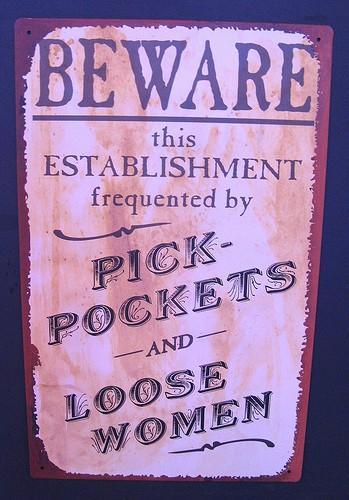 Pickpocketing is an old New York tradition. An urban phenomenon, it requires big crowds and lots of people with reams of cash, which aren’t to be found in quiet rural areas. It probably dates back to the very first cities. In his sonnet sequence Astrophel and Stella, Sir Philip Sidney declared, “I am no pick-purse of another’s wit,” which shows that the trade must have been flourishing in the streets of Elizabethan England. And the duc de Saint-Simon in his famous memoirs tells how Louis XIV, on horseback, saw a pickpocket emptying the pocket of the duc de Villars, one of the king’s greatest generals, at which point His Majesty rode up to the thief, hit him with his cane, and had him arrested; so even the royal presence did not deter this profession. In fact when, after much debate with his advisers, the king opened Versailles to the public, so as to dazzle his subjects and all the world, it meant opening the palace and its grounds to that same age-old profession. ATTENTION AUX PICKPOCKETS warn signs in Versailles even today.
Pickpocketing is an old New York tradition. An urban phenomenon, it requires big crowds and lots of people with reams of cash, which aren’t to be found in quiet rural areas. It probably dates back to the very first cities. In his sonnet sequence Astrophel and Stella, Sir Philip Sidney declared, “I am no pick-purse of another’s wit,” which shows that the trade must have been flourishing in the streets of Elizabethan England. And the duc de Saint-Simon in his famous memoirs tells how Louis XIV, on horseback, saw a pickpocket emptying the pocket of the duc de Villars, one of the king’s greatest generals, at which point His Majesty rode up to the thief, hit him with his cane, and had him arrested; so even the royal presence did not deter this profession. In fact when, after much debate with his advisers, the king opened Versailles to the public, so as to dazzle his subjects and all the world, it meant opening the palace and its grounds to that same age-old profession. ATTENTION AUX PICKPOCKETS warn signs in Versailles even today. The Conjuror, by Hieronymus Bosch. But more than conjuring is going on here.
The Conjuror, by Hieronymus Bosch. But more than conjuring is going on here. Can you find the pickpocket?
So of course the gentle art has always been practiced in New York. In the years following the Civil War a host of Sunshine and Shadow books authored by journalists were published to satisfy the public’s appetite for information about the vast city on the Hudson, the Sunshine segment dealing with splendid buildings, parks, theaters, and the arts, while the Shadow segment dealt with crime and vice and corruption, including every kind of thievery.
These books catalog in detail what I call the Ladder of Thieves, a hierarchy acknowledged by the thieves themselves and rising from the ranks of the lowest to the highest. So let’s take a glance at the Ladder, before focusing on pickpockets. On the lowest rung were hat and coat and boot thieves, who took any loose object in sight; they were devoid of skill and ran few risks. Likewise the hog thieves, who grabbed a hog running loose on the street, tossed it in a cart, and dashed off. Those above these lowest of the low held them in the utmost scorn. (About those omnipresent hogs: they really did belong to someone, but the owners let them range freely about the streets so they could gat free eats gobbling up edible garbage.)
At the next level up were the pickpockets and shoplifters, whose trade required real skill, and above them the second-story sneaks who, while a family were all downstairs at dinner, scaled a pillar of the front stoop to enter a second-story window and help themselves to any valuables, jewels above all, to be found in the empty bedrooms.
On the next rung up were the bond thieves. Dressed respectably, a bond thief would pass through the railing in a broker’s crowded front office with a pen behind his ear and a paper in hand, and with a comment like “Permit me one moment” or “Excuse me, sir” would penetrate the back office with ease, the busy brokers thinking him one of their clerks. The intruder would then scoop up any cash, bags of coin, or negotiable bonds deposited on a desk or in a safe left carelessly open, and merrily depart. The chagrinned brokers often negotiated with the thief to get half the valuables back on condition that they not prosecute.
At the very top of the ladder were the safe busters, whose occupation required great daring and skill and much advance planning. Entering quietly at night, some blew the safe open, snatched the contents, and left within minutes. But subtler ones pried the safe open with special instruments, making no noise whatsoever. To these aristocrats of crime went the greatest spoils, and of course the envy and admiration of all the city’s other thieves, those denizens of the rungs below them.
The pickpockets had to learn their craft, were educated in schools by experienced professionals. They dressed well, had delicate hands with long, slender fingers. Pleasing in appearance and speech, they plied their trade in stages and horsecars, at crowded ferry docks and theater entrances, in churches, among throngs watching a parade or a fire or a street fight, or wherever crowds of people jostled together in confusion. The experienced pickpocket had a delicate touch, never searched for anything, knew exactly where the coveted object was and how to get it. He or she was observant, well aware that people entering or leaving a bank often feel their purse in a pocket, telling the thieves exactly what they needed to know. And their skill was such that they were rarely apprehended.
The female of the species might follow a lady into a shop, sit beside her, chat with her, waiting for the victim’s moment of distraction that would give the thief her opportunity. Or she might ride a Broadway stage, courteously ask a gentleman sitting next to her to raise or lower a window, and as he did so relieve him of his watch or wallet, thank him graciously, and promptly get off. But perhaps the crowning act of effrontery of a female thief was to attend a funeral all in black, veiled, perhaps weeping copious tears into a black silk handkerchief, so as to lift valuables from the mourners or even the dear departed. No doubt about it, the pickpockets of that era, male and female alike, were cunning, industrious, and daring.
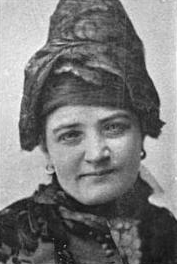 A notorious New York pickpocket was Sophie Lyons (1848-1924), whose pedigree included a grandfather safe buster and a shoplifter mother who was also the “keeper of a disorderly house” on the East Side. Sophie’s first husband was a pickpocket who vanished into a state prison, following which she married a bank robber named Ned Lyons. A skilled pickpocket and consummate actress, if caught by a victim Sophie could register every shade of emotion and often persuaded the victim to let her go. Sent to Sing Sing in 1871, she was rescued the following year by Lyons, who got into the prison disguised and broke through the wall of her cell, following which they vacationed for a while in Paris, visiting their skills upon that cosmopolitan metropolis. Returning to New York, Sophie continued her colorful career, and in 1880 hauled her 14-year-old son George into court, requesting that he be sent to a juvenile facility because of his unruly behavior. A family shouting match followed, with George screaming that his mother was a thief and shoplifter who had two husbands and went all over the country stealing. The judge ruled that the son should be held in custody while the claims of mother and son could be investigated. How the matter was finally resolved is unclear, but one suspects that Sophie was not the ideal mother.
A notorious New York pickpocket was Sophie Lyons (1848-1924), whose pedigree included a grandfather safe buster and a shoplifter mother who was also the “keeper of a disorderly house” on the East Side. Sophie’s first husband was a pickpocket who vanished into a state prison, following which she married a bank robber named Ned Lyons. A skilled pickpocket and consummate actress, if caught by a victim Sophie could register every shade of emotion and often persuaded the victim to let her go. Sent to Sing Sing in 1871, she was rescued the following year by Lyons, who got into the prison disguised and broke through the wall of her cell, following which they vacationed for a while in Paris, visiting their skills upon that cosmopolitan metropolis. Returning to New York, Sophie continued her colorful career, and in 1880 hauled her 14-year-old son George into court, requesting that he be sent to a juvenile facility because of his unruly behavior. A family shouting match followed, with George screaming that his mother was a thief and shoplifter who had two husbands and went all over the country stealing. The judge ruled that the son should be held in custody while the claims of mother and son could be investigated. How the matter was finally resolved is unclear, but one suspects that Sophie was not the ideal mother.In 1913, at age 65, after many ups and downs in her career, Sophie Lyons retired from crime, wrote a memoir, Why Crime Does Not Pay, that was published, and became a philanthropist and prison reformer in Detroit. Honesty seems to have paid for her, since her real estate and business investments came to half a million dollars and she owned 40 houses. In 1922 she came home to find her house ransacked in her absence and bonds worth $7,000 and diamonds worth $13,000 missing. She died in Detroit in 1924.
 Another pickpocket who achieved, for a while and at cost, considerable renown was George Appo (1858-1930), a street kid who slipped naturally into pickpocketing, and whose memoir has to date been published in part, with commentary. A pickpocket from an early age, he graduated into the green goods game, a swindle in which the victims paid good cash for a satchel of what they thought was counterfeit money, only to find, when they opened it later, sawdust or shredded paper or bricks. Those swindled could hardly complain to the police, being would-be circulators of counterfeit money, and the swindlers reveled in the thought that they had broken no law, since their operation involved no genuine counterfeit bills. And who were the victims? Appo chronicled Southerners embittered by the recent war and eager to defraud the federal government; debtors; farmers afraid of losing their farm; small businessmen trying to stave off bankruptcy; and even a black preacher from Florida who needed funds to build a church. Though aware of the game, the police did not interfere, since cheats were cheating cheats.
Another pickpocket who achieved, for a while and at cost, considerable renown was George Appo (1858-1930), a street kid who slipped naturally into pickpocketing, and whose memoir has to date been published in part, with commentary. A pickpocket from an early age, he graduated into the green goods game, a swindle in which the victims paid good cash for a satchel of what they thought was counterfeit money, only to find, when they opened it later, sawdust or shredded paper or bricks. Those swindled could hardly complain to the police, being would-be circulators of counterfeit money, and the swindlers reveled in the thought that they had broken no law, since their operation involved no genuine counterfeit bills. And who were the victims? Appo chronicled Southerners embittered by the recent war and eager to defraud the federal government; debtors; farmers afraid of losing their farm; small businessmen trying to stave off bankruptcy; and even a black preacher from Florida who needed funds to build a church. Though aware of the game, the police did not interfere, since cheats were cheating cheats.Less lucky than most pickpockets, in the course of his eventful career Appo achieved intimate familiarity with the Tombs, the penitentiary on Blackwell’s (now Roosevelt) Island, and the notorious state prison of Sing Sing, whose lockstep and rule of silence he detested, and whose torture in the form of the Paddle he has vividly described: a naked inmate was fastened to a board and beaten with a perforated paddle whose holes acted like suckers and raised blisters on his flesh, or even tore parts of his flesh off, following which he might be sent back to work or, if in a state of collapse, confined to the “Dungeon,” a tiny, dark cell where his only companion was a slop bucket.
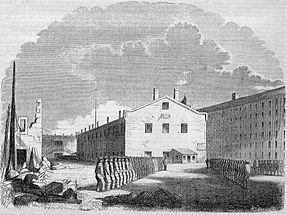 Sing Sing in 1855, showing the lockstep that Appo so hated.
Sing Sing in 1855, showing the lockstep that Appo so hated.Fame came to Appo in 1894 when, eager to leave the crooked life, he appeared before a state senate committee investigating police corruption in New York City, where his testimony created a sensation. Further fame came later that same year when he appeared in a melodrama about crime, playing himself in one short scene, and his name was plastered on billboards all over the city. Here, long before the reality shows of TV today, fact and fantasy met, just as in Buffalo Bill’s Wild West Show, which for a season featured Sitting Bull and his braves, the future nemesis of Custer. But Appo was brutally wrenched back into the totally real when the police, angered by his testimony, assaulted him and framed him, and his lawyer, to preserve him from further retaliation in prison, had him declared insane and lodged for a while in a state hospital for the criminally insane, from which he was finally discharged in 1899. In his later years he lectured merchants about street crime, worked as an undercover agent for the Society for the Prevention of Crime, and started writing his autobiography. Having survived more than a dozen physical assaults, including bullets in the stomach and head, and scars from a knife attack on his throat, he died of old age in 1930.
Everyone needs a break from their work, and the New York thieves were no exception. Their balls were often held in a Fourth Ward dive kept by an old housebreaker, the proceeds going to hire a lawyer for a comrade who had been arrested. Thieves of every level attended, the distinctions between them momentarily forgotten. To the screechy music of a fiddle and a banjo, such luminosities of crime as Mother Roach and Big Nose Bunker might be seen cavorting together, or Scotch Jimmy with Wild Maggy, or Baboon Connelly with Sugar Nell, in a rapid succession of Virginia reels and round dances that toward the end of the evening achieved a climactic frenzy.
Now let’s fast-forward to the twentieth century. Was the trade flourishing in these more modern times? You bet. Pickpocketing was still a profession for which one had to be trained. A veteran thief would train five initiates who would then go on to acquire experience and each in turn train five more, and so the occupation continued. Initiates needed a steady hand, patience, and a light touch. One has told of entering one such school in 1969 and finding a room filled with half-dressed mannequins. A bell was installed on each mannequin, and the trainees had to lift a wallet without ringing it. As the teacher said, “You have to be a pianist.” The pickpocket who told this story worked the city streets in a suit or casual clothes and on a good day pulled in $2,000. He took great pride in lifting wallets from women in the revolving door at Macy’s; the victim would go on into the store, while he would exit onto the street and hail a taxi.

This would seem to indicate that pickpocketing is alive and well in New York City today, but in the twenty-first century this is not the case. Pickpocketing is, in fact, a dying art. If there were 23,000 cases of pickpocketing in the city in 1990, by 1995 the number had fallen by half, and by the year 2000 it was under 5,000. What accounts for this? The proliferation of surveillance cameras; longer sentences; among younger would-be thieves, a lack of the patience required, and a preference for robbing at gunpoint; and above all the widespread use of debit and credit cards, so that people carry much less cash on their person. Result: the old apprenticeship system has withered away.
 Watch out for those sly geezers.
Watch out for those sly geezers.Not that pickpockets have vanished completely. There are still occasional reports: a woman in Queens whose purse was taken by a young man while two confederates chatted with her about her baby; a woman robbed in the East Village by a suspect whom a bank surveillance camera revealed to be a harmless-looking young woman in “hipster” glasses who, having swiped a wallet, then uses the ATM card in it to drain the victim’s bank account; a proliferation of pickpockets flocking to crowded stores in downtown Flushing, where the business community is working with the police to fight the invaders; and middle-aged male pickpockets of the old school who work the subways, using razor blades to deftly cut pockets and remove money and mobile phones without so much as scratching the victim, one thief being 80 years old, and some with over 30 arrests on their record. “Surgeons with a razor blade,” the police have termed this latter group with grudging admiration, while numbering them, as of November 2011, at exactly 109.
A pickpocket with a difference is Pierre Ginet, a Frenchman who gave up his law studies at the Sorbonne for sleight-of-hand performances. A veteran of the Cirque du Soleil, in 2013 he performed at the Big Apple Circus at Times Square, where he invited circusgoers onto the stage and robbed them while the crowd looked on. His preferred targets were men with a jacket, preferably with glasses or a tie as well, and with facial hair, since the hirsute are, in his opinion, more fragile. He sees the tourist crowds in Times Square, their wallets stuffed with money and their bags with valuables, as especially vulnerable, all the more so since their attention is focused elsewhere. And subway straphangers are a pickpocket’s dream, since they hold on to the high bars and thus leave their jackets hanging open and their bags exposed. So watch out, commuters. M. Ginet always returns what he steals, but other practitioners might not be so considerate.
Quite apart from magicians, the art of pickpocketing is in decline, but it still makes sense to be wary in crowds and keep your valuables deep in inside pockets. Not for nothing do the greenmarkets mount signs BEWARE OF PICKPOCKETS, but in noticing such signs avoid the instinctive gesture of patting your wallet reassuringly, since that tells pickpockets just what they need to know. And above all don’t pass out drunk or fall asleep while seated in the subway; you may wake up minus your wallet and five stops past your station – it happens all the time.
Source note: Selections from George Appo’s autobiography, accompanied by commentary, appear in Timothy J. Gilfoyle’s A Pickpocket’s Tale: The Underworld of Nineteenth-Century New York (2006). It is well worth a read.
Monsanto: Followers of this blog know that Monsanto is the company I love to hate. And I am not alone: on Saturday, May 24, there was a global demonstration against Monsanto in over 400 countries, with some 2 million people attending worldwide. Demonstrators called for a permanent boycott of genetically modified organisms (GMOs), food transparency (foods with GMOs to be labeled), and a transition to local, organic, and sustainable agriculture. In the U.S. there were demonstrations in 47 states; in New York, protesters marched from Union Square to Brooklyn. GMOs are now at least partially banned in many countries, though not – of course – in the U.S., where Monsanto people hold important positions in government. And what did the New York Times say of all this? To my knowledge, nothing. And WNYC, our local NPR station? Again to my knowledge, nothing. For them, I guess, this wasn’t worth reporting.
 Demonstrators in Vancouver.
Demonstrators in Vancouver.Rosalee Yagihara
This is New York
 InSapphoWeTrust
InSapphoWeTrustComing soon: Remarkable Women: Ayn Rand. Her books are still read today. Why?
© 2014 Clifford Browder
Published on June 08, 2014 04:30
June 1, 2014
129. Ethnic New York: Tibetans, Afghans, Mohawks
Here now are some more interesting ethnic groups to be found in and around New York. But for an unusual twist, I’ll begin by mentioning Gamal, who delivers take-out to us from a nearby restaurant. Though his English is quite good, I knew he was from Uzbekistan, but when I questioned him further, he explained that he was not an Uzbek but a Tatar, and graduated from the University of Tashkent. Tashkent … Uzbekistan … Tatar … These words speak to my uninformed Western mind, conjuring up visions of long westbound caravans on the Silk Road, the endless steppes of Central Asia, mysterious nomadic peoples, Genghis Khan and the Golden Horde. But Gamal presents a modern-day reality. He and his family came here a few years ago for better opportunities, and to get free of the corruption prevalent in Uzbekistan. Here they have launched a business supplying provisions to restaurants, and it is expanding now across several boroughs. Gamal delivers take-out in his spare time simply to earn a little extra cash. When he comes to us he invariably flashes the warmest smile and gives us the heartiest of greetings. But we may lose him, for he and his family may in time move to Boston because of the lower rents and shorter commutes there. But for now we are fortunate to enjoy the services of this friendly Tatar from Uzbekistan, the embodiment of the city’s ethnic diversity.
Tibetans
The Jackson Heights section of Queens is one of the most ethnically diverse neighborhoods in New York. 74th Street between Roosevelt Avenue and 37th Avenue is the heart of Little India, where Indians and other South Asians have predominated, though more recently Latin Americans have settled there, too. Women in saris are seen on the streets with their children, retailers offer Indian music and Bollywood films, and Indian restaurants abound, but among the Indian jewelry and sari shops and Ecuadorean bakeries one often sees strings of brightly colored cloth rectangles fluttering in the breeze, and pictures of some revered figure. The rectangles are the prayer flags inscribed with symbols, mantras, and prayers that Tibetans install in front of their residence or place of spiritual practice so that, fluttering in the breeze, they can bring happiness, long life, and prosperity to the residents and neighbors. And the pictures are of His Holiness, the Fourteenth Dalai Lama. For here in the midst of Little India is what amounts to a Little Tibet.
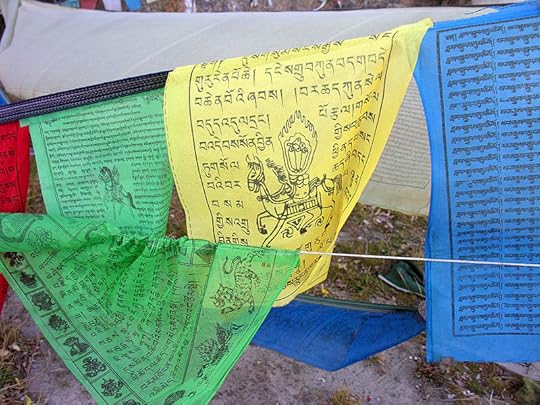 Tibetan prayer flags.
Tibetan prayer flags.Dennis Jarvis
Tibet: a remote and mysterious land that Westerners have always thought of as the rooftop of the world, bordered by the towering snow-capped Himalayas, with Buddhist monasteries, shaggy beasts called yaks, a vast hilltop palace in Lhasa, the capital, and a culture going back thousands of years. The spiritual leader of Tibet, the much revered Dalai Lama, is believed to be the reincarnation of the previous Dalai Lama, and is found after the high lamas seeking him receive a vision in a sacred lake that guides them to one or several boys who must then pass a series of tests until the future Dalai Lama is found. This can take years – four in the case of the present Dalai Lama.
 A yak.
A yak.Dennis Jarvis
 The palace in Lhasa.
The palace in Lhasa.Balou46
Our view of this legendary land changed forever once the Communist Chinese took control of the country in 1950 and in 1959 crushed a Tibetan uprising, causing the Dalai Lama to flee over the towering Himalayas to India, soon followed by some 80,000 Tibetans. Granted sanctuary by the Indian government, the Dalai Lama established a government in exile, and every year more Tibetans emigrated to India, Nepal, or Bhutan, and small numbers of them began migrating from these countries to the West. By 1985 there were 524 Tibetans in the U.S. Then a section of the Immigration Act of 1990 authorized the issuing of a thousand immigrant visas to Tibetans living in Nepal and India, following which there has been a steady immigration to these shores.
There are now at least 10,000 Tibetans here, probably more, with about 4,000 in New York City, the largest Tibetan community in the U.S., mostly concentrated in Queens. Some came from India, Nepal, or Bhutan, but others were born here and have never set foot in the mysterious land of their family’s origin. But they feel welcome here, where the plight of Chinese-dominated Tibet arouses much interest and sympathy. And they can become citizens, whereas in India and Nepal they have only refugee status, with few rights as citizens. But many hope to earn enough money here so they can move on to Minnesota or Wisconsin, where there are large Tibetan communities and a less stressful environment for raising a family.
Many Tibetans here are undocumented, so the women work as nannies, housekeepers, and caregivers for the elderly, and are much in demand, having a reputation for being patient, diligent, soft-spoken, and caring. The men find work as interpreters or translators, or drive cabs or sell produce in greenmarkets or become construction workers, but some work in – O irony! – Chinese restaurants. Inevitably, many older Tibetans don’t know English and find it hard to adjust to American life. They may ride the subway a short distance to attend a Tibetan prayer session, but otherwise they depend on family for social life, and if that is limited because their relatives are away at work, their life here can be bleak: prayers at home and maybe a very short walk to a park.
Since many Tibetans came here from India, they feel comfortable in the Little India section of Jackson heights, where restaurants like the Himalayan Yak Restaurant on Roosevelt Avenue offer authentic Tibetan and Nepalese food, including the Tibetan dumplings known as momos, and noodles, soups, and sausage, as well as a Tibetan tea with yak butter and salt; being modern as well as traditional, the Yak Restaurant even has a blog. The yak meat offered in these restaurants is said to be juicier than beef and so delicious that one taste of it may lead to addiction. But in this country until recently yaks existed only in crossword puzzles, so where does yak meat come from? From Colorado and Wyoming and Idaho, where yaks are now being raised by American ranchers eager to accommodate a profitable and growing niche market.

Unlike many immigrant ethnic groups here, the Tibetans are highly political. Students for a Free Tibet was organized here in New York in 1994 to campaign for human rights and independence in Tibet. Whenever there is unrest or riots in Tibet, in fair or foul weather they and other groups picket the Chinese consulate at 520 Twelfth Avenue daily, even to the point of being fined for missing work. “This is not politics,” a young Tibetan insisted once, “this is human rights. I am for the rights of others as well as mine.” In 2012 three Tibetans staged a one-month hunger strike outside the U.N. building to demand that the U.N. establish a fact-finding delegation to assess the situation in Tibet. And they are organized, with a worldwide network. In New York alone there are at least five very active groups, all advocating for Tibetan interests and concerns, including a Free Tibet movement that, following the teachings of the Dalai Lama, is nonviolent. But the protesters are not immune to frustration and anger; during one protest in 2008 one of them shattered a window in the consulate.
[image error]A Students for a Free Tibet demonstration.
Medill DC
 His Holiness, toes and all.
His Holiness, toes and all.Luca Galuzzi The Dalai Lama has often come to New York to give teachings on various aspects of Buddhism and to address huge gatherings of the general public. Spiritual and inspiring he certainly is, but he also has a sense of humor. I once heard him in a radio interview announce that there would be a discussion and lots of “blah, blah, blah.” He seems adept at managing a fine balance between taking himself very seriously and having a quiet chuckle at his own expense.
But His Holiness is aging; after he is gone, the Free Tibet movement, given the intransigence of the Chinese Communists, may find it hard to remain nonviolent. Nor is it clear how the next Dalai Lama will be chosen; the Chinese authorities are bound to try to manipulate the process to their own advantage. Be that as it may, even Tibetans born here feel a loyalty to the homeland they have never seen. Most become U.S. citizens, but deep inside they remain Tibetan. Some keep an altar in their apartment where they light incense and offer water daily to statues or pictures of various buddhas and gurus, but others insist that spirituality is cultivated internally and requires no outward observances. Being greatly concerned lest their children growing up here become too Americanized, they take pains to instruct them in Tibetan culture and have them learn the Tibetan language.
Afghans
One woman in Flushing, Queens, whose grandson is a doctoral candidate at the New School, tells how the FBI raided her home, rummaging through her closets while ignoring her protests that she had lived here for 25 years. Who called the FBI in? The intruders wouldn’t say, but she’s sure it was a downstairs neighbor. And the owner of a restaurant claims that he can spot the FBI on sight, and they him: “Yeah, we all know each other.” All this, of course, after 9/11. Such is the troubled life of the Afghan community in New York.

Afghanistan is a landlocked, mountainous country in Central Asia, historically almost as remote as Tibet, with towering snow-covered peaks, arid plains, and sandy or stony deserts. It is an impoverished and underdeveloped country with a hodgepodge of peoples and languages, and a harsh climate: a land ravaged in recent times by war and civil strife, terrorism, and a flourishing opium trade that defies all efforts to eradicate it. Clearly, a land that many might want to leave. Afghans may have started coming here as early as the 1920s. More came in the 1930s and 1940s, most of them educated and some with scholarships to study in American universities. Afghan immigration increased after the 1979 Soviet invasion, when asylum passports were granted freely by the U.S. government, and increased again after the Taliban took control of Afghanistan in 1996, and yet again after the U.S. bombing began in 2001.
Unlike their predecessors, these later immigrants came not enamored of the dream of America, but out of sheer necessity, with little knowledge of English or of American society, and sometimes even illiterate in their own language. Though glad to be here, they were – and are -- strangers in an alien land, with the largest communities in California and the Northeast. Most are Sunni Muslims, but ethnically they may be Pashtun (the majority), Tajik, Uzbek, Hazara, Aimaq, Turkmen, Baloch, or various other ethnicities, including even a few Jews.
Today there are at least 9,000 Afghans – some sources say as many as 20,000 – in the New York City area, most of them in various locations in Queens, with the biggest concentration in Flushing. Here in Manhattan, without knowing them as Afghans, we encounter the men as cab drivers, restaurant workers, and coffee and bagel cart vendors. Many of the women are stay-at-home mothers with little exposure to American society, but others take jobs below their former status in Afghanistan and work as housekeepers or babysitters.
Soon after 9/11 a Tajik imam, the spiritual leader of a mosque in Flushing, accused the mosque’s Pashtun founders of supporting the Taliban and expelled them from the premises. The founders accused the imam in turn of inventing these charges so as to gain control of the mosque, sued, and regained control of the mosque by court order, following which the imam and his Tajik followers were forced to leave. Which goes to show the internal divisions that also afflict the Afghan community in New York.
When the U.S. intervened militarily in Afghanistan, some local Afghans were angry, feeling that Saudi Arabia, not Afghanistan, should be blamed for 9/11, since most of the hijackers were Saudis. But others celebrated the intervention, convinced that a defeat of the Taliban would be a blessing. Yet all of them are leery of FBI surveillance and aware of being suspect in the eyes of fellow New Yorkers, who have shouted “Terrorist!” at them only too frequently and called them a wild, barbaric people.
On September 14, 2009, with a visit to the city by the President coincidentally imminent, armed federal agents raided three apartments in Flushing at gunpoint, breaking in by force in the middle of the night to rummage through closets, drawers, and even purses, searching for explosive devices or their components that were allegedly to be used on targets in the New York area. No such devices were found, though the police removed computers, cellphones, and other material; the men detained were interrogated and then released. The whole neighborhood was upset, and those targeted, a cab driver and two pushcart vendors among them, protested their innocence, insisting that they worked hard six or seven days a week and had no time for, or interest in, politics.
 Najibullah Zazi But the alleged plot was not mere fantasy. Those targeted had been visited recently by a casual acquaintance, Najibullah Zazi, who was soon arrested in Denver for planning suicide bombings in the New York subway system ordered by al-Qaeda; later he pled guilty and agreed to testify against his fellow conspirators. Because surveillance had revealed the plot, his case has been cited by the Obama administration to justify massive government monitoring of phone calls and e-mails. And the Afghan community in New York, even as it adjusts to American ways, continues to feel alien and besieged.
Najibullah Zazi But the alleged plot was not mere fantasy. Those targeted had been visited recently by a casual acquaintance, Najibullah Zazi, who was soon arrested in Denver for planning suicide bombings in the New York subway system ordered by al-Qaeda; later he pled guilty and agreed to testify against his fellow conspirators. Because surveillance had revealed the plot, his case has been cited by the Obama administration to justify massive government monitoring of phone calls and e-mails. And the Afghan community in New York, even as it adjusts to American ways, continues to feel alien and besieged.But change is coming. In traditional Afghan society, where family and tribal bonds are strong, and the sense of family honor fierce, most women wear headscarves and show no flesh below the neck, and must not make eye contact with a man in public. As for education, they have little or none, marry early as the family dictates, and are subservient to their husband for the rest of their life. These restrictions have been loosened to some extent in recent years, but still prevail.
 Afghan women in a market.
Afghan women in a market.Imagine, then, the shock when a traditionally raised Afghan woman finds herself planted in American society, where no such rules apply. Yes, she is in a tight-knit Afghan community, but circumstances may force her to take a job outside. The contrast between the traditional life she has known and what she sees all around her is overwhelming. And yet, Afghan women are said to adjust even better than the men. They do find jobs outside the home, and they do want education.
Answering that need locally is Women for Afghan Women (WAW), a Queens-based human rights organization founded in April 2001, six months before 9/11, that advocates here and in Kabul for the rights of Afghan women. Funded by government and nongovernment agencies and private donations, it helps women here with immigration issues, parenting, family matters, and domestic violence. A Women’s Circle holds popular monthly meetings with lectures and discussions, and a chance for women to share experiences and provide mutual support. There is also a girls’ leadership program, and free classes in English, computer skills, driving, and applying for U.S. citizenship.




As for the organization’s work in Kabul, one story sums it all up. A girl named Somaya grew up in Herat, Afghanistan. Her father had two wives and abused her mother. One day, at age nine, she came home to find her mother in a pool of blood; her father had stabbed and killed her. The father went to prison, but Somaya’s stepbrothers tried to force her to marry a rich older man in exchange for a large dowry; when she refused, they beat her and locked her in a darkened room. Finally, when she was allowed to go home with her uncle for a brief stay, she went back to school and told her teacher everything. The teacher got the stepbrothers arrested, and arranged for Somaya to stay in a women’s shelter. Finally she was transferred to Women for Afghan Women’s halfway house in Kabul, where she was able to return to school. She dreams of becoming a lawyer so she can work for the rights of women.
Against the background of Afghan history and the role of women in traditional Muslim societies, Women for Afghan Women’s program is nothing short of revolutionary. Even today, in regions where Muslim extremists prevail, a girl or young woman who wants education risks kidnapping, acid in the face, or death. What do the extremists most fear? Drone strikes? No. Boots on the ground? No again. Free elections? Not even this. It's the education of women. An educated woman, even if she remains a good Muslim, is lost to them; she will begin to think and act for herself. She threatens all the repressive aspects of her traditional society; she is a symbol of hope for others. The extremists must eliminate her, or their own cause will in the long run be doomed. This conflict is under way now in Afghanistan and other Muslim countries; there is evidence of it in the news almost daily.
But even here in New York there are risks for the educated Afghan woman. Sometimes these young women seem too Westernized to be suitable mates for Afghan men, who prefer to find wives among communities still living in Afghanistan or Pakistan. Progress is slow and uneven; often it is three steps forward, two steps back. But it doesn’t stop, it continues. And it continues right here in New York.
Mohawks
There are many other immigrant groups in and around New York City that I could mention: Turks, Armenians, Ukrainians, Koreans, Croatians, Thai – the list is endless. Instead, I’ll end with a very special group who have contributed hugely to the city’s skyline, helping make it what it is today: the Mohawks. They aren’t immigrants at all, of course, since they were here long before the rest of us; by comparison, we are the immigrants.
Some of them once lived with their families in Brooklyn, but most of the two hundred working here now live during the week in boarding houses or apartments or motels scattered across the metropolitan region, and then on Friday afternoon begin the six-hour drive 400 miles north to the Kahnawake reserve on the south bank of the Saint Lawrence River about 20 miles from Montreal, to spend the weekend with their families. Then on Sunday night they begin the long trip back to New York, arriving at the job site just in time for work.
It all began in 1886, when the Canadian Pacific Railroad wanted to build a bridge over the Saint Lawrence River, one end of which would be on their property, and agreed to hire tribesmen. The railroad meant to use them simply to unload supplies, but at every chance they got, the young Mohawks would go out on the bridge and climb up high. Seeing that the Mohawks seemed to have no fear of heights, and needing riveters for dangerous work high up, the railroad began training them, and they worked on many jobs in Canada. Then in 1907, when the collapse of another bridge under construction killed 33 Mohawks, the Mohawk women insisted that, rather than all working on the same site, their men work in smaller groups on a variety of projects. So they began coming to New York, where such projects were plentiful. And thus a people with age-old traditions centered in the earth left that earth far behind to work here in high steel.
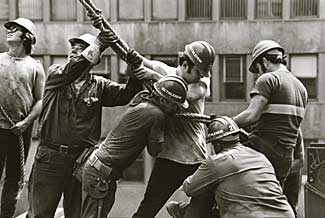 © 2014 David Grant Noble The Mohawks weren’t the only workers in high steel; many European immigrants worked there, too. But the fathers, grandfathers, and even great-grandfathers of today’s Mohawk workers guided bars of steel into the skeletons of the city’s skyscrapers and bridges, and now a fourth generation is helping rebuild the World Trade Center site. On 9/11 Mohawks working on other projects flocked to the Twin Towers to help people escape from the flaming buildings, and when the towers came crashing down, they helped look for victims and, over the months that followed, worked in the cleanup of what some of them had helped build years before. Recently they worked frantically to make One World Trade Center rise by one floor every week; scheduled to open in 2014, the 104-story structure is the tallest in the Western Hemisphere, and the fourth tallest in the world.
© 2014 David Grant Noble The Mohawks weren’t the only workers in high steel; many European immigrants worked there, too. But the fathers, grandfathers, and even great-grandfathers of today’s Mohawk workers guided bars of steel into the skeletons of the city’s skyscrapers and bridges, and now a fourth generation is helping rebuild the World Trade Center site. On 9/11 Mohawks working on other projects flocked to the Twin Towers to help people escape from the flaming buildings, and when the towers came crashing down, they helped look for victims and, over the months that followed, worked in the cleanup of what some of them had helped build years before. Recently they worked frantically to make One World Trade Center rise by one floor every week; scheduled to open in 2014, the 104-story structure is the tallest in the Western Hemisphere, and the fourth tallest in the world. Says one Mohawk ironworker, “One job I’ll always remember is working on the transit hub at the World Trade Center. Some of the iron was huge. I’ll never forget that feeling of seeing those pieces of iron, some thirteen feet high and sixty feet long, flying at you. Awesome.” And years ago another said, “It’s like you’re on top of the world. When you are up there you can see all over Manhattan. You’re like an eagle.”
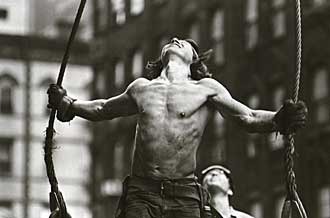 © 2014 David Grant Noble
© 2014 David Grant NobleAnd recently another said, “A lot of people watch us and ask me if I’m crazy, but it’s fun. You got to love what you do.” And there he is, a fourth-generation Mohawk hardhat, 27 stories up, straddling an I-beam on top of a new skyscraper rising on 55th Street, with gloved hands grabbing a steel beam lifted high in the air by a crane and knocking it into a support column with a resonant gong.
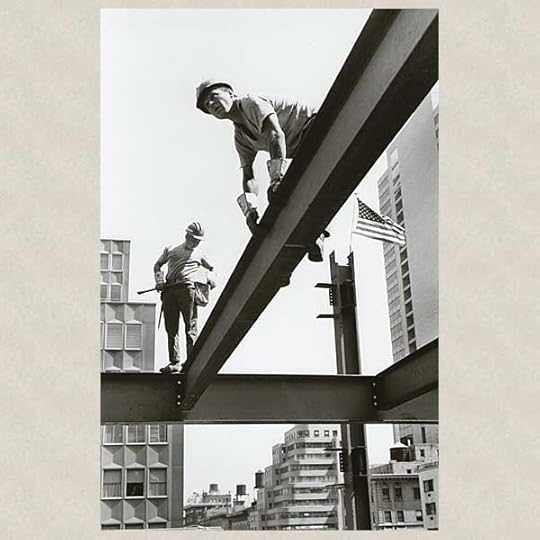 © 2014 David Grant Noble
© 2014 David Grant NobleThe perilous work of steel workers perched on beams or clinging to cables high above the city without any safety apparatus visible, as they built the Empire State Building in the early 1930s, was captured by photographer Lewis Hine in photographs that, just to look at them, make you gasp and tremble and your legs go flimsy. Perhaps the most famous photo attributed to Hine shows eleven workers, some of them Mohawks, casually having lunch while sitting on a beam high in the air with no safety net below them, a photo that never fails to astonish me. Yet according to official records only five men died during the building’s construction, and only one by falling off a scaffold.
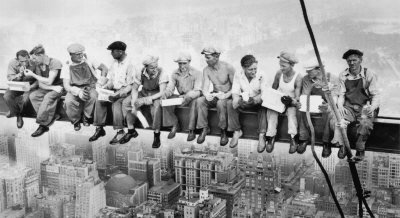
Are the Mohawks really fearless in such work? Some Mohawks say yes, but others insist that they’re just careful in following the rules: when walking on a girder, put one foot in front of the other and look ahead, never look down. Do they ever fall to their death? Yes, occasionally. Many graves on the reserve are marked with crosses made of steel girders.
(The photo of eleven workers having lunch has usually been attributed to Hine, and the construction site identified as the Empire State Building in 1932. But recently it has been revealed that the photo was taken on September 20, 1932, by an unknown photographer, and that it shows workers, two of them identified as Irish, working not on the Empire State Building but on Rockefeller Center.)
But the Mohawk “skywalkers” love what they do. And what have they and others done in the past? Rockefeller Center, the Empire State Building, the Chrysler Building, Madison Square Garden, the U.N. building, the World Trade Center – you name it. And most of the city’s bridges as well. It’s a long six-hour commute from Canada, but it pays well and the benefits are good. But if there are 200 Mohawk ironworkers here now, in the 1950s there were 800. It’s hard work, and dangerous; now more young Mohawks are working in a tobacco industry flourishing on the reserve. And some ironworkers urge their sons to find other, less dangerous jobs. So maybe the tradition is dying: dying slowly, but dying. Time will tell.
Source note: Three of the photos in this post are from “Gallery 2: The Mohawk Steelworkers Series,” on photographer David Grant Noble’s website: davidgrantnoble.com. He took them of Mohawks at a building site on Park Avenue and 53rdStreet in 1970 and has generously allowed me to use them here.
This is New York

Coming soon: The Gentle Art of Pickpocketing: An Old New York Tradition. Have you ever had your pocket picked here in New York? If so, let me know. In the works: Ayn Rand, lean, hard, angular, and dry, yet her books are still selling. But did this ardent foe of government intervention sign up for Social Security and Medicare? Startling revelations to come.
© 2014 Clifford Browder
Published on June 01, 2014 04:46
May 28, 2014
128b. More Eccentrics.
One of the followers of this blog sent this comment, after viewing post #128 on Village Eccentrics. It is too charming not to be included in a post, albeit a short one, a sort of postscript to #128.
In the mid-Sixties, I experienced an interesting period at WBAI that began when my secretary handed me an old-fashioned calling card introducing an imposing, smartly dressed septuagenarian who called himself Lord Rosti, and claimed to be the Grand Maître de la Cour for his Serene Highness, Prince Robert de Rohan Courtenay, Grand Duke Sebassto of the Byzantines. WBAI attracted many memorable people in those early years, but these two gentlemen—who played their roles to the fullest and had apparently been doing so since the 1920s—were the most interesting of the self-generated variety.
They came to me in 1966 for help in meeting certain requirements for a seriously overdue coronation. These included fifty Vestal Virgins and a rather large number of rare flamingoes from Japan's Imperial Gardens. We were unable to help meet those specific needs, but we did the next best thing by staging a coronation at Cheetah, New York's first discotheque. The year was 1966 and the actual crowning was performed by Andy Warhol, with incidental music by an obscure Tiny Tim, writhing by a barely clad lady and her boa constrictor, and the title ape from "Gorilla Queen: swinging from the rafters. I wish we had thought of taking photos, but we were a radio station and we didn't even broadcast it.
This brings to mind another eccentric whom I almost met back in the 1970s. His name was, I believe, Maurice, and he professed to be the founder and chief celebrant of the Old Catholic Church of Brooklyn. I never met him, but heard of him through friends, and once visited his apartment with mutual friends in his absence. My partner Bob recalls a grandiose painting of him in full ecclesiastical garb, a long robe that reached to the floor. What I myself distinctly recall is a framed letter on official Vatican stationery acknowledging with gratitude the receipt of a letter of consolation from the Old Catholic Church of Brooklyn following the death of Pope John XXIII in 1963. Was this concoction a joke, a sort of hobby, or a deep plunge into the misty realms of fantasy? I have no idea. I never met him, but Bob did, and he assures me that he was no nut, but a very sophisticated person. The Internet informs me that there is indeed an Old Catholic Church that has split off from Roman Catholicism, but I suspect that the Old Catholic Church of Brooklyn had nothing to do with it, being the private fantasy of its founder.
Coming soon: As announced, more ethnic groups, with prayer flags, burqas or the lack of them, and workers walking narrow girders at perilous heights. In the offing: The Gentle Art of Pickpocketing: An Old New York Tradition. And another remarkable woman: Ayn Rand.
© 2014 Clifford Browder
Published on May 28, 2014 04:37
May 25, 2014
128. Village Eccentrics: Joe Gould and the Baroness
New York has always been a mecca for hustlers, and Greenwich Village, in its bohemian glory days before gentrification, was certainly a magnet for eccentrics. This post is about two Village eccentrics of yore. The high-rent West Village of today has an eccentric or two, but they pale in comparison with those of the early twentieth century, when the Village was still a low-rent district that attracted wannabe artists and writers and agitators, usually penniless, and the tourists who flocked there to live just a little bit dangerously by observing the scruffy inhabitants in their bars and cafés and getting just a little bit – or maybe more than a little bit – drunk. So here are two inhabitants who would not have disappointed the visitors.
Joe Gould
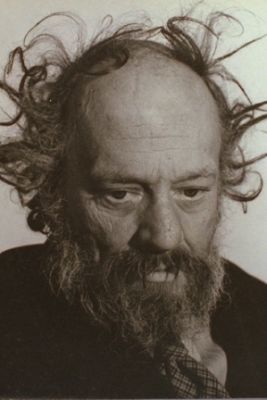
He called himself Professor Sea Gull and Hot Shot Poet from Poetville, and the Village bartenders who served him, when he could cough up the price of a drink or, more likely, get someone else to pay for it, called him the Mongoose and other things as well. Only 5 foot 4 in height and weighing less than a hundred pounds, he knocked around the Village for decades with a wild, bushy beard and rumpled clothing, his balding pate topped by a beret or a yachting cap, his mouth graced with an ivory cigarette holder. Born to an old Boston family in 1889, he was a Harvard graduate who had come to New York in 1917 to work as a journalist, but soon learned that he could not or would not hold a steady job and succumbed to the charms of bohemia. Long before the Beatniks made dropping out fashionable, he professed to despise the automobile, the radio, zippers, money, and writers and reviewers, and dismissed skyscrapers and steamships as “needless bric-a-brac.”
Perennially penniless and sometimes homeless, Gould slept in flophouses or on benches in parks, and in diners wolfed down free ketchup by the spoonful. Turning up at Village parties to gobble snacks and gulp down cocktails, he would jump up on tables to give lectures with impossibly long titles, or deliver his poem “The Sea Gull” by leaping about, flapping his arms, and screaming, “Scree-eek! Scree-eek!” Or he recited his two-line “religious” poem: “In the winter I’m a Buddhist, / In the summer I’m a nudist.” He was charming, he was silly, he was close-lipped with the aura of a brooding genius, and he was always – or was always trying to be – entertaining.
But Joe Gould was more than just a clown and an eccentric; he was, the Villagers believed, a genius in the rough, a writer. Not just an ordinary, run-of-the-mill writer – the Village was full of them – but a very special kind of writer. Scribbling in longhand in dime-store composition books (he scorned the typewriter), he was writing a huge work-in-progress, “An Oral History of Our Time,” consisting of life histories told him by others that he had written down with the help of total recall, the chapters having titles like “The Good Men Are Dying like Flies” and “Why I Am Unable to Adjust to Civilization, Such As It Is.” He insisted that the nine-million-word Oral History weighed more than he did, and that later generations would hail him as the most brilliant historian of the twentieth century, his writing destined to last as long as the English language. Impressed, local poets, artists, shopkeepers, and restaurant owners gave him handouts of money or food to speed the project on its way. Starting in 1944 he was subsidized by a patron who worked through an intermediary and insisted on remaining anonymous, thanks to whose largesse he was lodged in a clean, comfortable room in a rooming house in Chelsea. Gould was obsessed at first with learning the identity of his benefactor, but never did. The subsidy was terminated abruptly in 1947, without explanation, and Gould soon ended up in yet another Bowery flophouse. The patron later turned out to be a Chicago heiress named Muriel Gardiner. Why she suddenly cut Gould off remains a mystery.
Not everyone, I suspect, treasured Joe Gould’s less than subtle sense of humor. Not everyone welcomed his barging into their party to gobble viands and make like a sea gull or recite – yet again! – his two-line poem. His repertoire was admittedly limited. And not everyone believed in his oral history, since its nine million words were nowhere in evidence, the manuscript being allegedly stashed for safekeeping at various sites in New York and New Jersey. Certainly he was a clown; was he a con man as well?
No, said journalist Joseph Mitchell, who met Gould in 1942, talked with him at length, and published a profile of him, “Professor Sea Gull,” in the New Yorker. Though he had never seen the manuscript, Mitchell believed in its existence, and his article made Gould a media event and tourist attraction. Reporters flocked to him, strangers bought poems from him, photographers found in him a willing subject, and there was even a Joe Gould Club in postwar Manila. Yet when Mitchell put Gould in touch with several New York publishers interested in publishing excerpts of his opus, nothing came of it. Gradually, Mitchell came to the belief that Gould was indeed a con man, and that the manuscript was a colossal hoax.
Meanwhile Gould’s health was fast deteriorating. He suffered dizzy spells, then confusion and disorientation, and collapsed on the street in 1952. Hospitalized in the psychiatric division of Bellevue Hospital, he was transferred to Pilgrim State Hospital in Brentwood, Long Island, where he died of arteriosclerosis and senility in 1957. He is buried in an unmarked grave in Ferncliff Cemetery in Westchester. In 1964 Mitchell published another profile in the New Yorker, “Joe Gould’s Secret,” revealing that the “Oral History” didn’t exist.
But that’s not quite the end of the story. In 2000 The Village Voice reported the discovery, in the archives of New York University, of eleven composition books constituting an 1100-page diary in Gould’s near-illegible scrawl, meticulously recording his daily life from 1943 to 1947, a work evidently unknown to Mitchell, who died in 1996. Gould had given them to an artist friend who, failing to find a publisher, later sold them to an archivist who sold them in turn to NYU. Was Gould then a literary genius after all? Alas, the diary simply recorded baths taken (for Gould, an event), meals eaten, dollars bummed, with the focus always on himself. His comment on V-J day and the end of the war? “There were a few bedbugs. So I slept poorly. Also there was a lot of noise.” Hardly material to enrich posterity. Yes, Joe Gould was a con man, but at least he was an interesting one, and the money he got by it was trivial; let’s not begrudge him that.
Baroness Elsa von Freytag-Loringhoven
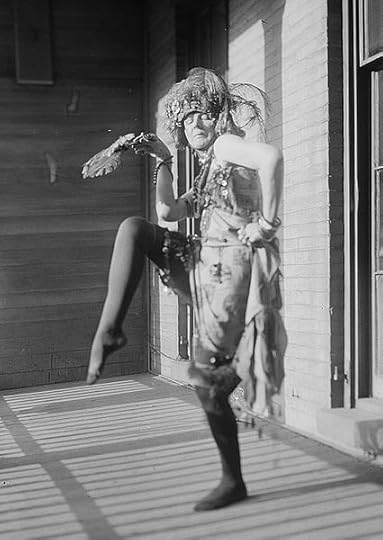 In all her glory. She burst into Greenwich Village in 1913, Dada incarnate with a bit of Surrealism thrown in, and was soon the most gossiped about, wondered about, photographed and sketched and painted, and praised and reviled character on the scene. Her outfits, like her art, consisted of objets trouvés (found objects) that she scavenged from trash on the city’s sidewalks. She showed up at the office of the avant-garde Little Review, which had published some of her incoherent poetry, in a bolero jacket, kilt, spats, and dime-store bracelets (she was definitely not in the chips), with tea balls hanging from her breasts. Her morals were as eccentric as her dress, for on that first visit the light-fingered visitor filched five dollars in stamps. And since she needed more than found objects for her art, she shoplifted art supplies from department stores and was arrested more than once, becoming intimately acquainted with the Jefferson Courthouse jail.
In all her glory. She burst into Greenwich Village in 1913, Dada incarnate with a bit of Surrealism thrown in, and was soon the most gossiped about, wondered about, photographed and sketched and painted, and praised and reviled character on the scene. Her outfits, like her art, consisted of objets trouvés (found objects) that she scavenged from trash on the city’s sidewalks. She showed up at the office of the avant-garde Little Review, which had published some of her incoherent poetry, in a bolero jacket, kilt, spats, and dime-store bracelets (she was definitely not in the chips), with tea balls hanging from her breasts. Her morals were as eccentric as her dress, for on that first visit the light-fingered visitor filched five dollars in stamps. And since she needed more than found objects for her art, she shoplifted art supplies from department stores and was arrested more than once, becoming intimately acquainted with the Jefferson Courthouse jail.
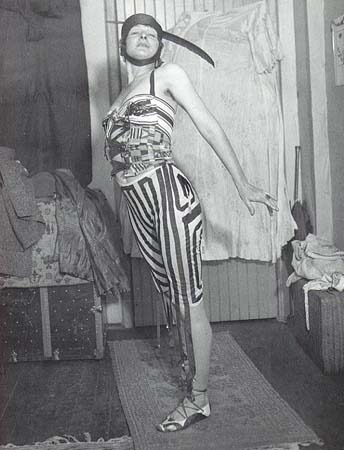
An instant legend, her startling presence became a fixture at Village romps and revels, where she appeared with teaspoons or matchboxes as earrings, a bra composed of tomato cans, a birdcage around her neck with a live canary inside, false eyelashes made of parrot feathers or porcupine quills, and hats made from peach baskets or wastepaper baskets. She marched into a reception for the British coloratura Marguerite d’Alvarez with a peacock fan, one side of her face adorned with a canceled U.S. postage stamp, her lips painted black, her face powder yellow, with the top of a coal scuttle for a hat. What the singer thought of this is hard to say.
She lived in a tenement on West 14thStreet amid squalor that visitors did not find picturesque, with stray cats and dogs poking about in the clutter of scavenged objects; by all accounts the place simply stank. On her forays from there she carried small dogs and large sculpted penises, these last a significant icon since she was aggressive in pursuit of men. When she made a pass at Wallace Stevens, he refused to set foot below 14th Street lest he encounter her again. And a Russian painter, when he turned on the light in his apartment one night, was startled to see her crawl out naked from under his bed. Alarmed, he fled to a neighbor across the hall, but the intruder refused to leave the premises until the painter agreed to follow her up to her own apartment.
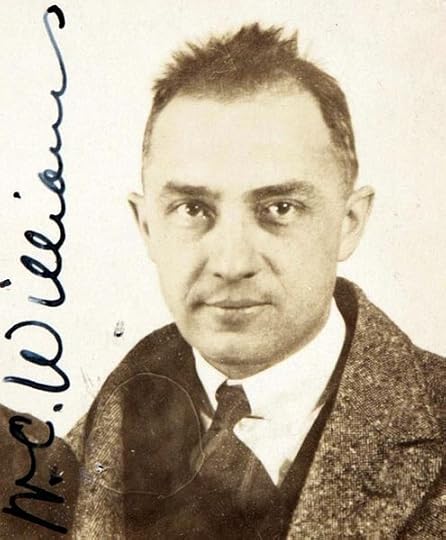 William Carlos Williams, a 1921 passport photo. In his autobiography William Carlos Williams tells of seeing a sculpture of hers that looked like chicken guts in wax and, hearing that she loved his poetry, decided to look her up – not easy, since she was in jail for stealing an umbrella. So he met her on her release, a fiftyish woman with a lean, masculine figure and a strong German accent, and took her to lunch. He was attracted to her, and on a later occasion she informed him that what he needed to make him great was to contract syphilis from her and thus free his mind for serious art – a suggestion that he chose to ignore. She pursued him for months, and when he proved to be uncooperative, hit him on the neck with all her strength. So Williams bought a small punching bag and began practicing his jabs. The result: when she attacked him again one evening on Park Avenue, he flattened her with a stiff punch to the mouth. He then had her arrested, and from behind bars she promised not to bother him again. Heartbroken by this rejection, she is said to have shaved her head and lacquered it vermilion, then stole the black crepe from the door of a house in mourning and made a dress of it. Always an artist, always unpredictable.
William Carlos Williams, a 1921 passport photo. In his autobiography William Carlos Williams tells of seeing a sculpture of hers that looked like chicken guts in wax and, hearing that she loved his poetry, decided to look her up – not easy, since she was in jail for stealing an umbrella. So he met her on her release, a fiftyish woman with a lean, masculine figure and a strong German accent, and took her to lunch. He was attracted to her, and on a later occasion she informed him that what he needed to make him great was to contract syphilis from her and thus free his mind for serious art – a suggestion that he chose to ignore. She pursued him for months, and when he proved to be uncooperative, hit him on the neck with all her strength. So Williams bought a small punching bag and began practicing his jabs. The result: when she attacked him again one evening on Park Avenue, he flattened her with a stiff punch to the mouth. He then had her arrested, and from behind bars she promised not to bother him again. Heartbroken by this rejection, she is said to have shaved her head and lacquered it vermilion, then stole the black crepe from the door of a house in mourning and made a dress of it. Always an artist, always unpredictable.As for her poetry, it bristled with phrases like “spinsterlollypops” and “Phalluspistol.” But what should one make of this?
Narin-----Tzarissamanili (He is dead) Ildrich mitzdonja-----astatootch Ninj-----iffe kniek----- Ninj-----iffe kniek! Arr-----karr----- Arrkarr-----barr
Or:
Neighing Stallion: HUEESSUEESSUEESSSOOO HYEEEEEE PRUSH HEE HEE HEEEEEEAAA OCHKZPNJRPRRRR
I leave it to equinophiles to decide to what extent this conveys the neighing of a horse.
When printed in The Little Review alongside chapters of James Joyce’s Ulysses, her effusions elicited two responses: some readers hailed her as an avant-garde genius, while others begged the Review to stop printing gibberish. The latter view has since prevailed, but feminist scholars have hailed her as a pioneering woman and neglected artist who exerted a significant influence on the Dada movement, and seen in her the first American performance artist. In 2011 her mostly unpublished poetry was published posthumously as Body Sweats, which caused the New York Times to salute her as a “furiously witty and aggressively erotic experimental writer,” though I haven’t had the courage to look into it.
Was she really a baroness? By marriage, yes. But who really was she? Recent scholarship has given us some clues. She was born Else Plötz in Swinemünde in Pomerania, Germany, in 1874, her father a mason who abused her in her childhood. Escaping young in 1892, she became an actress and vaudeville performer and, sexually hungry from an early age, mingled limbs and loins with artists in Berlin, Munich, and Italy. Tall, slender, and handsome, in 1901 she married August Endell, a renowned Berlin Jugendstil (Art Nouveau) architect, but soon became involved with a friend of his, poet and translator Felix Paul Greve, thus initiated a merry ménage à trois that for a while bounced around the continent together. She and Endell divorced in 1906. Greve meanwhile was convicted of fraud and served a year in prison, his reputation shattered, though he used his time inside to write a roman à clef recounting Elsa’s sexual escapades. After his release she and Greve lived in voluntary exile in Switzerland and then in France, and were married in Berlin in 1907.
Greve was soon in deep financial trouble again, so in 1909 with Elsa’s help he faked his own suicide and sailed for Canada, then relocated to Pittsburgh, where his wife joined him in 1910. The couple briefly ran a farm in Kentucky, though the idea of Elsa on a farm anywhere is both ludicrous and enigmatic, but she wasn’t there for long. Greve left her in 1911 and moved to Canada, where he remarried without bothering to divorce Elsa, and took the name Frederick Philip Grove and became a well-known Canadian novelist. Deserted in rural Kentucky and with only a limited command of English, to support herself Elsa modeled for artists in Cincinnati and finally ended up in New York where, in 1913, though technically still married to Greve, she married the impecunious German-born Baron von Freytag-Loringhoven, thus acquiring the title of baroness. Little is known of the Baron, but when World War I broke out in 1914, he set sail for Germany to join in the war effort, but was captured by the British en route and interned; later he committed suicide, leaving her nothing but her title.
To support herself in New York, the Baroness worked in a cigarette factory and posed as a model for various artists, including Man Ray. When Dada reached these shores, she was celebrated as its epitome, as one who dressed it, loved it, lived it. One of her more memorable “ready made” sculptures, often attributed to another artist, was a plumbing pipe she titled “God.” She may also have helped inspire Marcel Duchamp’s controversial sculpture “Fountain,” an upturned urinal; her love for him was apparently obsessive. She even starred in a short film by Duchamp and Man Ray entitled “The Baroness Shaves Her Pubic Hair,” beside which Andy Warhol’s later efforts seem to verge on timidity.
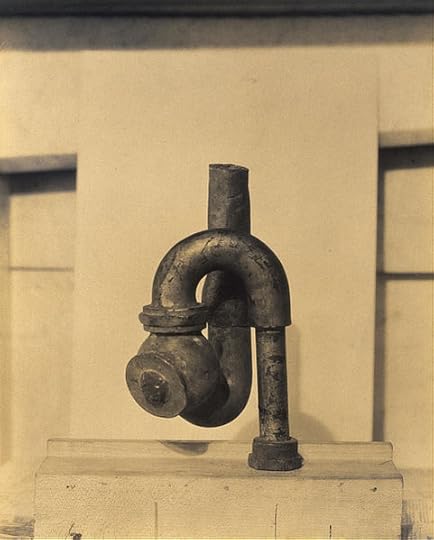 "God." But does it really belong
"God." But does it really belongin a museum?
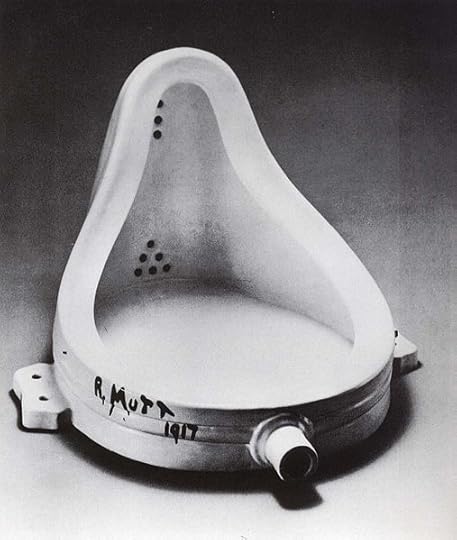 Duchamp's "Fontaine." It probably
Duchamp's "Fontaine." It probably upstaged "God."
When the war ended, many of her friends decamped for Paris, and she longed to follow them. With help from her Dadaist acquaintances, in 1923 she went back to Berlin, hoping for better opportunities there, but instead found an economy devastated by World War I. She remained there, impoverished and mentally unstable, immune to the decadent charm conveyed by Christopher Isherwood’s Berlin Stories, reduced to selling newspapers on the street. A letter to Djuna Barnes describes the ensemble she wore to the French consulate, hoping to get a visa that would let her go to Paris: ropes of dried figs around her neck, postage stamps as beauty spots on her emerald-painted cheeks, and topping her head a sugar-coated birthday cake with fifty flaming candles. The consulate officials probably decided that Paris had enough nuts already and didn’t need another; she didn’t get the visa. Meanwhile she was bombarding friends, acquaintances, and ex-lovers with letters and letter/poems pleading for money.
In 1926 an inheritance let her at last get to Paris, where Djuna Barnes paid the rent on her apartment, and she resumed modeling and tried to market her poetry to the few exile journals publishing in English. In 1927, at age 53, she died of asphyxiation in her apartment, when the gas was left on overnight. Suicide or an accident? It isn’t clear. She is buried in Père Lachaise Cemetery.
Artistic genius before her time, pioneer feminist, sexual adventuress, exhibitionist, obsessive narcissist, and nut – she has been called all these, and more. Certainly, when she came to New York, she crossed the vague line separating charming eccentricity and self-expression from out-and-out weirdness, but that was just what the Dadaists wanted. Dada raged for a few brief years in Paris and Germany, but to judge by photographs the Dadaists there dressed more or less normally and put weirdness into their art; she was unique. And yet, in her later years at least, she seems to have been mentally unstable. As for her death, maybe it really was suicide; being perpetually onstage and perpetually broke may have worn her out. And if she is celebrated by feminists today, I suggest that posthumous celebration from a safe remove is quite different from dealing with such a phenomenon in the flesh. Given her brazen advances and grotesque behavior, even in such an enlightened age as ours some people might be perversely tempted, taking inspiration from William Carlos Williams, to punch her in the mouth.
This is New York
 Schuyler Shepherd
Schuyler Shepherd
Coming soon: More immigrants: yak meat and momos, and why prayer flags flutter in the breeze; getting free of the burqa in an alien land; and how a people who revere the earth came to work high in the sky.
© 2014 Clifford Browder
Published on May 25, 2014 04:52
May 18, 2014
127. Ethnic New York: Sherpas, Basques, Gypsies, Sikhs
Immigrants are an integral part of New York City; we couldn’t do without them. My partner Bob’s doctor is Norwegian, his home-care aides are Haitian and Russian, his Visiting Nurse is Cambodian, and her most recent substitute was Filipino. And on Saturdays I buy bread, scones, and apples from Tibetans in the Abingdon Square Greenmarket.
This post is about certain groups of immigrants, often ignored by the rest of us, who live here and contribute to the city’s patchwork of diversity. Especially, it is about the most exotic, most alien groups, their customs and beliefs so different from mainstream America’s, and about how and why these peoples came to New York.
Sherpas
Sherpas in New York City? That very special ethnic group in Nepal who guide climbers to the top of Mount Everest, the highest mountain in the world, sixteen of whom perished in a killer avalanche, causing some Sherpa guides to quit for the season and many to protest the conditions of their work? Here, so far from the Himalayas? Yes, here, a mere handful first coming in the mid-1980s and more thereafter, so that there are now some 2,500 or more of them, mostly in the ethnically diverse Elmhurst section of Queens, the biggest Sherpa community in the country. And they are grieving for their comrades who died on the mountain.
 A Sherpa guide. Wouldn't you rather drive a taxi?
A Sherpa guide. Wouldn't you rather drive a taxi?Pem Dorjee Sherpa
Why are they here? Because some of them realized the risks of their traditional profession of guiding wealthy foreigners to dangerous mountaintops, so those intrepid thrill-seekers could bask in the glory of accomplishment and see their names in newspapers, followed laconically by “and six Sherpa guides.” Because, if they renounced that profession, they could find no other work as lucrative in Nepal. Because a lengthy civil war in Nepal scared mountain-climbing tourists away, depriving the guides of a livelihood. Because they want to transition to another way of life. Because in New York they can make good money.
“Climbing was in my blood,” says one. But after getting married and starting a family, he stopped climbing for his own safety. And what does he do for a living here? What many of them do: he drives a cab. A “good, bad, ugly job,” he calls it, working twelve-hour shifts six nights a week. His chief complaint: people having sex in his car.
Are the Sherpas here, good Buddhists for the most part, adapting to life in hectic America? Perhaps it can best be summed up by two links posted on the United Sherpa Association website: “Nepal Sherpa Guide” and “Sherpa Computer Services.” So it goes when one comes down from the mountains and plunges into the canyons and labyrinths of New York City.
Basques
They first came to this country lured by the gold rush in California, taking the long trip by sea around the southern tip of South America into the Pacific and up to San Francisco, where so many dreams came to dust, though not the dust of the goldfields. But who were they, coming such a long distance from the homeland where they had lived since prehistoric times?
The Basques are a people living in north central Spain and southwestern France, straddling the Pyrenees. Their origins are a mystery, since their language is unrelated to Indo-European languages and probably predates the arrival in Europe of the Indo-European peoples. Basque tribes are mentioned by Roman writers and were probably remnants of early inhabitants of Western Europe. In recent times the Basques have been featured in the news because of their desire for greater autonomy in Spain, with the organization ETA advocating outright independence and committing acts of terrorism, but in 2010 the group declared a permanent ceasefire that is still in effect.
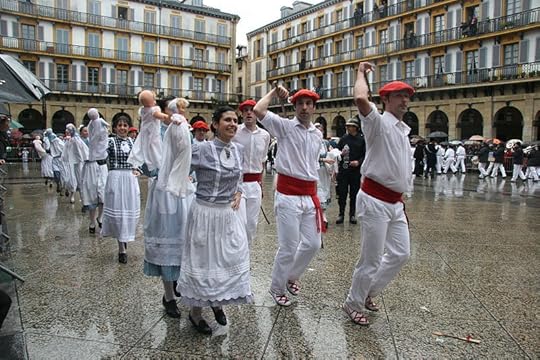 A Basque festival in Spain.
A Basque festival in Spain.dantzan Today, reflecting their initial influx in the mid-nineteenth century, there are large Basque communities in the Western states. In New York City the first Basques began arriving after the completion of the transcontinental railroad in 1869. Departing from Bordeaux or Le Havre, some, having worked as dock workers, came to work in the harbor, whereas others planned to move on west by railroad, but ended up staying in New York, where they found work in the ports of New York and New Jersey. For those from rural areas the city was overwhelming, but others were energized by it. The first Basque community took hold at the foot of the Brooklyn bridge along Cherry and Water Streets in Manhattan. There were Basque groceries and restaurants, Basque delivery services, and Basque wine and beer distributors, and most of the Basques attended Mass at the nearby Catholic churches, one of which even had a Basque priest.
It was to this small but growing community that a young Basque named Valentín Aguirre came to work as a tugboat stoker in the harbor, and then on the city’s boats and ferries, before opening a Basque boardinghouse in 1917, the Casa Vizcaína on Cherry Street, that catered exclusively to Basques. He married here, and his Basque wife helped run the boardinghouse. When they were old enough to drive, he sent his young sons to meet incoming ships at the docks and call out, “Euskaldunak emen badira?” (“Are there any Basques here?”). Arriving Basques would shout back in relief and joy, “Bai, bai! Ni euskalduna naiz!” Of course they lodged at the boardinghouse, by then renamed the Santa Lucia Hotel and located at 82 Bank Street in Greenwich Village, which functioned as a travel agency as well, getting train tickets and information about jobs for those bound for the West, and seeing them off with bundles of food for the long train trip ahead.
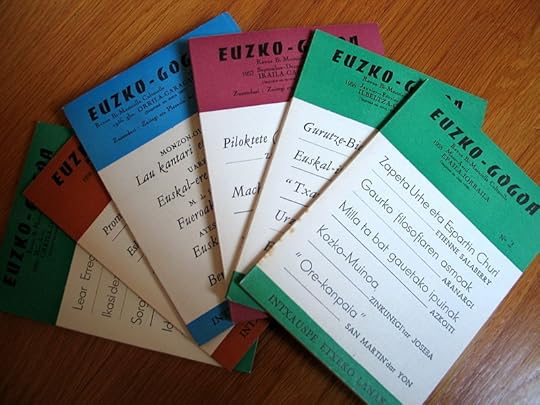 A Basque magazine.
A Basque magazine.Joxerra
In 1913 Valentín Aquirre and other Basques formed the Centro Vasco-Americano, originally as a mutual-aid society to help members financially if in need. The organization continued through the years, and in 1973 it bought a building at 307 Eckford Street in Brooklyn, where, with the name in English of New York Basque Club, they are still located today, though the Basques in the city now are scattered throughout the five boroughs. In October 2013 they celebrated their centennial with lectures, concerts, dancing and singing, plus participation in the annual Columbus Day Parade. Among the many activities they offer are lessons in Euskara, the language of the Basques, the only one predating the Indo-Europeans that is still extant in Europe today: a reminder of the mysterious origins of this persisting people.
Romani or Gypsies
In France they have been accused of shocking living standards, exploitation of children for begging, criminal acts and rioting, and prostitution, and thousands have been expelled and their illegal camps dismantled; one camp was even set on fire by a mob. Greek and Irish authorities have suspected them of abducting children. Italy has announced a “nomad problem” and initiated forced evictions. A Czech town tried to build a wall between its wealthy neighborhood and their ghetto, and some schools in Eastern Europe have posted signs “WHITES ONLY.” Many of these people are unemployed, most live in poverty, and the temptation to crime is admittedly strong.
Such is the plight of the Gypsies, also called Romani or Rom or Roma, in Europe today. Is it any wonder that they want to come over here, where the prejudice against them, however strong, is less than in the Old World where they have lived for centuries? But just as with the Basques, one has to ask, Who are they?
A people presumably of Indian origin who arrived in Europe at least a thousand years ago, the Romani are widely dispersed, many living in various parts of Europe and, since the nineteenth century, in the Americas, with a million now in the U.S. The name “gypsy” derives from “Egyptian,” reflecting the common medieval belief that the Romani, with their swarthy complexion, had come from Egypt. Their language, Romani, is Indo-European, but variations of it are so different that seven of them are considered separate languages.
 Croatian Gypsy women with their children, 1941. Just the kind of image that reinforced
Croatian Gypsy women with their children, 1941. Just the kind of image that reinforced European prejudice against them.
German Federal Archives
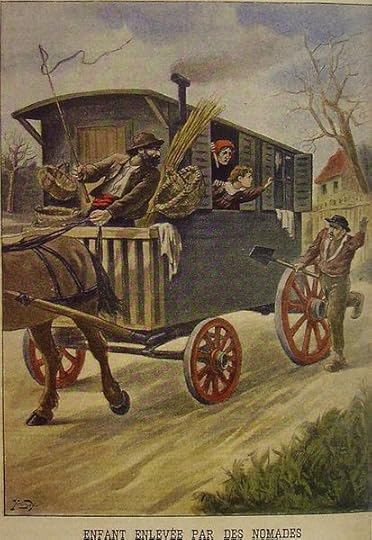 An old print showing Gypsies
An old print showing Gypsies kidnapping a child. Over the centuries the Romani have been persecuted in Europe as unassimilated, rootless nomads, allegedly ungodly, lazy, and given to petty theft and the kidnapping of children. Viewed by the Nazis as an inferior race, between 500,000 and 1.5 million died in the holocaust. Yet in literature and art they have often been romanticized as well, with supposed powers of fortunetelling, a passionate temperament, and a love of freedom. (Think of Bizet’s Carmen.)
Romani from Serbia, Austria-Hungary, and Russia began emigrating to the U.S. in the 1880s, until the outbreak of war in 1914 and the tightening of immigration restrictions in 1917 halted this early influx. Some were coppersmiths, others were fortunetellers. Musicians and singers from Russia settled in New York, and in 1904 a group recently arrived from England were living in a camp of wagons with curtained windows in a meadow near Broadway and 211thStreet in Manhattan, and making their living as horse traders and fortunetellers. Other Romani from Bosnia who worked as animal trainers and showmen settled in a village of homemade shacks in the Maspeth section of Queens from about 1925 to 1939, when their shacks were razed.
The collapse of Communism in Eastern Europe in 1989 led to a renewed flow of Romani emigration to the U.S. Here in New York City they often live in small communities in Brooklyn, the Bronx, and Queens that keep to themselves. They are by no means homogeneous; those from Hungary may have little in common with those from Slovakia; some may be Christian and others Muslim; some speak one dialect of the Romani language, while others speak another. In the neighborhood north of Pelham Parkway in the Bronx, some 350 families of Macedonian Romani live in a tight-knit Muslim community content to be viewed by others as Italian or Greek. Why did they come here? To find work for themselves and educational opportunities for their children that they couldn’t find in Europe.
In this country the Romani have escaped the overt persecution that still plagues them in Europe, but not the stereotypical image of them as irresponsible migrants and cunning thieves, an image reinforced by their tendency to hold themselves apart so as to avoid contamination by the larger society surrounding them. Yet today they are in many ways assimilated into the mainstream culture, while clinging to their traditional customs. They may speak to ghosts, but gobble hamburgers at McDonalds. They marry their daughters off in arranged marriages in their early teens, but work as car salesmen or jazz musicians, and one is an electrician who coaches soccer for Romani boys. But once they achieve a degree of success, to escape any chance of prejudice they often stop referring to themselves as Romani and identify themselves as Slovakian or Romanian or whatever their country of origin may be. Many of the most recent arrivals are undocumented, have no English, and consequently have trouble finding work.
Often preferring to be invisible, and with many differences – cultural, linguistic, and religious – among them, Romani communities here, unlike many immigrant groups, have failed to create statewide or nationwide organizations to promote and defend their culture. But recently this has begun to change. In September and October 2013 the Ninth Annual New York Gypsy Festival was held in New York, with jazz, swing, folk, hip-hop, and funk concerts by performers from India, Turkey, Macedonia, Italy, France, the Netherlands, and the U.S. Here, finally, was a bold attempt to publicize the Romani culture through music both traditional and modern, and to break down age-old prejudices and celebrate “the Gypsy spirit.” A tenth festival is planned for 2014.
Who has been the most famous Romani? Would you guess Charlie Chaplin? Chaplin always claimed to have been born in London, but had no birth certificate to confirm it. In 2011 it was reported that a letter written to him in 1971 and only recently discovered states that he was born in a caravan in a gypsy community in the West Midlands that was ruled by a gypsy queen, the writer’s aunt. Perhaps wanting to conceal his gypsy origins, Chaplin kept the letter locked in a writing desk in his bedroom. The desk was inherited by his daughter Victoria, who, finding this one drawer locked, hired a locksmith to force the drawer open. Now his family is trying to confirm the story.
Sikhs
 Dr. Prabhjot Singh On the evening of September 21, 2013, Columbia University professor Dr. Prabhjot Singh, a practicing physician, was attacked by a gang of 25 to 30 black youths near 110th Street and Lenox Avenue. They yelled “Get him!” and “Osama!” and “Terrorist!” and grabbed his beard and punched his face repeatedly, knocking him to the ground. Before bystanders could come to his aid, he sustained injuries to his lip and jaw that required hospitalization. His offense: wearing a turban; he is a Sikh. In a press conference later Dr. Singh expressed no anger or desire for revenge, but the hope that his assailants would engage and learn in some other way. He had no intention of leaving Harlem, where he lived with his wife and infant son, and planned to return at once to treating his patients. A gentle man, a gentle religion.
Dr. Prabhjot Singh On the evening of September 21, 2013, Columbia University professor Dr. Prabhjot Singh, a practicing physician, was attacked by a gang of 25 to 30 black youths near 110th Street and Lenox Avenue. They yelled “Get him!” and “Osama!” and “Terrorist!” and grabbed his beard and punched his face repeatedly, knocking him to the ground. Before bystanders could come to his aid, he sustained injuries to his lip and jaw that required hospitalization. His offense: wearing a turban; he is a Sikh. In a press conference later Dr. Singh expressed no anger or desire for revenge, but the hope that his assailants would engage and learn in some other way. He had no intention of leaving Harlem, where he lived with his wife and infant son, and planned to return at once to treating his patients. A gentle man, a gentle religion.Sikhs are believers in Sikhism, a monotheistic religion founded in the Punjab region of India in the fifteenth century. Early in the twentieth century many Sikhs emigrated to the U.S. and found jobs on farms in California, in lumber mills in Oregon, and in railroad construction throughout the West. Their presence reinforced the racism already prevalent in the area, which was directed especially at the Chinese, and as a result Congress passed the Immigration Act of 1917, which banned immigration from India and other regions, thus halting Sikh immigration for the next thirty years. Immigration quotas were established by legislation in 1946, but it was the Immigration Act of 1965 that made a difference, giving visa preference to applicants whose skills were needed; more Sikhs entered the country, mostly highly educated professionals who gravitated toward cities like New York, and many became citizens. Prominent Sikhs today include writers and lecturers, physicians like Dr. Prabhjot Singh, businessmen, scientists, and politicians. New York’s largest Sikh community is in the Richmond Hill section of Queens, where a gurdwara, or Sikh temple, opened in 1972.
Sikhs are required to wear a kirpan, or short sword, and when one of them was arrested for doing so on a New York subway in 1987, the case was dismissed when it was learned that this was a religious custom. April of the following year saw the first Sikh Day Parade in New York, with thousands of initiated males wearing their long hair and beards unshorn, topped by the mandatory turban, and Sikh women, some of them in brightly colored saris, and all of them with head scarves. The parade is still held annually in Manhattan, with free vegetarian food and nonalcoholic drinks available to everyone.
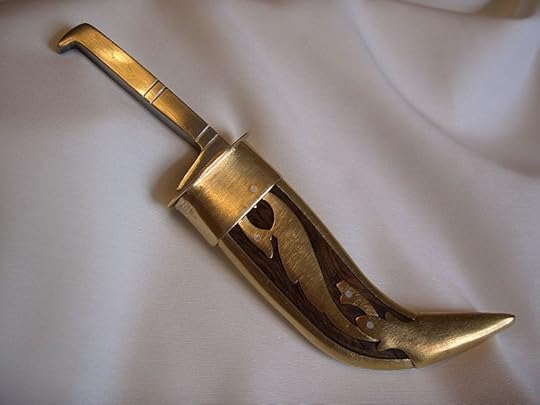 A kirpan.
A kirpan.Hari Singh The 9/11 attacks initiated a new phase in the history of Sikhism in New York and the U.S., for people often take the turban-wearing Sikhs for Arabs or Muslims, blame them for the attacks, and commit hate crimes against them. That an assault like the one on Dr. Prabhjot Singh could occur in supposedly liberal and enlightened New York alarmed many, myself included. Unfortunately, wearing the mandatory turban seems to make Sikhs a target for assault. This is all the more reprehensible, given the very nature of Sikhism, which strikes me as surprisingly modern, enlightened, and tolerant. Just consider these aspects of it:
· It makes no claim of exclusivity, but respects all monotheistic faiths. · It believes in the equality of all humans, including equality of the sexes, and abhors the Hindu caste system.· It shuns not just alcohol, smoking, and drugs, but also superstition, ritual, fasting, pilgrimages, and idolatry, and has no priests.· It honors honest work and charitable actions and sharing.· It has no quarrel with science.· It advocates a simple vegetarian diet.
Obviously, this is not a religion for bigots, male chauvinists, playboys and the idle rich. Nor, I suspect, would it be appropriate for hedge fund managers or dealers in derivatives. And carnivores might have a problem, too.
That such a religion, now the fifth largest in the world, suffers from the ignorance and intolerance of other Americans is a scandal, and even more so, given Sikhism’s commitment to tolerance and love. We should be honored to have Sikhs among us.
 A Sikh parade celebrating the Sikh New Year.
A Sikh parade celebrating the Sikh New Year.Joel Friesen
Death notice: In an earlier post I reported that I had signed a contract with Brown & Sons, a small new press (very small and very new), to publish a selection of posts from this blog; congratulations poured in from friends and acquaintances. Over the following months I then toiled diligently with the publisher to determine which posts would be published, and how arranged. But last Sunday I received this e-mail:
We regret to inform our authors that Brown and Sons Publishing must close its doors, due to understaffing, underfunding, and high volume of work. We will be restructuring and planning tentatively for a re-opening in late 2014. We must, necessarily, release all authors from their contracts. We will notify you in late 2014 of our plans. We encourage you to submit your manuscripts to other publishers and we wish you the very best in your endeavors.
As two witnesses can confirm, my reaction to this epistle was not teary regret, resentment, or astonishment, but hoots of laughter. While I wished this publisher well, I never quite believed in them. Somehow, their operation seemed too vague, too flimsy, and certainly too optimistic. So beat the drums slowly and play the fife lowly, as yet another small press is laid to rest. Of course there may be a resurrection later in the year, but let’s not count on Brown & Sons (“Life-impacting books by newsworthy authors”) rising from its ashes like the phoenix. Meanwhile, requiescat in pace. Ci-gît Brown et fils. (The “& Sons” always bothered me, as no sons were ever in evidence. But no matter.) So it goes in the world of publishing.
This is New York
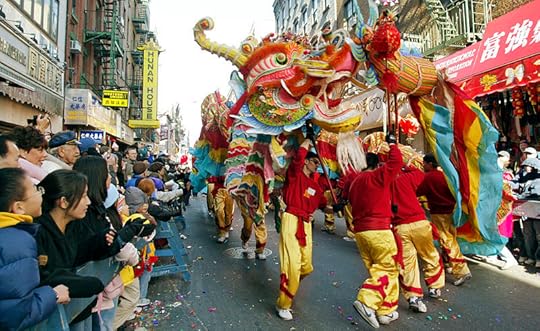 Patrick Kwan
Patrick KwanComing soon: Village Eccentrics of Yore. A bum who graduated from Harvard, slept in flophouses, and claimed to understand the language of seagulls; and a Baroness who wore a bra composed of tomato cans, eyelashes made of parrot feathers, and a birthday cake for a hat with fifty lighted candles. And here’s a line from her poetry: “Narin-----Tzarissamanili.” Of course that’s plucked from its context; I’ll give more next time, so readers can grasp the full beauty and meaning of the poem.
© 2014 Clifford Browder
Published on May 18, 2014 04:16
May 11, 2014
126. Hollywood in New York: Crawford, Garbo, Swanson, Hayworth
This post is about celebrities more associated with Hollywood than New York, but who, whether by choice or by necessity, lived here for a while and died here. Endings can be sad, but most of these are not; viewers will decide.
Joan Crawford
 I didn’t grow up feasting on her films, so I didn’t realize she could do more than play Queen Bee, until my partner Bob got me to see what he considers her two best films: Mildred Pierce (1945) and Sudden Fear (1952). I have to admit they were good, but what interests me here is her post-Hollywood career. After many years in film, in 1955, at age 51, she married her fourth and last husband, Alfred Steele, a Pepsi-Cola Company executive who later became chairman of the board and CEO. So began the strange but fruitful union of two distinctly American inventions, Joan Crawford and Pepsi-Cola. Over the next few years she traveled some 100,000 miles using her star image to promote, you guessed it, Pepsi-Cola, that quintessential American beverage and arch rival and nemesis of Coca-Cola. She appeared in commercials, TV specials, and televised beauty pageants, always reinforcing the message that “Pepsi-Cola hits the spot.” At the same time she was promoting this sugar- and caffeine-rich concoction, the company was promoting her, insisting insistently that Miss Crawford was a star and should be treated accordingly. (We don’t have royalty here, so this is the best we can do.) Whether she actually imbibed the stuff in private I have no idea.
I didn’t grow up feasting on her films, so I didn’t realize she could do more than play Queen Bee, until my partner Bob got me to see what he considers her two best films: Mildred Pierce (1945) and Sudden Fear (1952). I have to admit they were good, but what interests me here is her post-Hollywood career. After many years in film, in 1955, at age 51, she married her fourth and last husband, Alfred Steele, a Pepsi-Cola Company executive who later became chairman of the board and CEO. So began the strange but fruitful union of two distinctly American inventions, Joan Crawford and Pepsi-Cola. Over the next few years she traveled some 100,000 miles using her star image to promote, you guessed it, Pepsi-Cola, that quintessential American beverage and arch rival and nemesis of Coca-Cola. She appeared in commercials, TV specials, and televised beauty pageants, always reinforcing the message that “Pepsi-Cola hits the spot.” At the same time she was promoting this sugar- and caffeine-rich concoction, the company was promoting her, insisting insistently that Miss Crawford was a star and should be treated accordingly. (We don’t have royalty here, so this is the best we can do.) Whether she actually imbibed the stuff in private I have no idea. 
When her husband died in 1959, she was named to the board of directors, the company’s president lauding “Miss Crawford’s intimate knowledge and rare skills in promotion and public relations to which she has so superbly demonstrated to our benefit for the last four years.” (If you have trouble with the syntax of that statement, so do I.) Though she received an award in the shape of a bronze Pepsi bottle for her contribution to sales, all was not well in the long run, and in 1973 she was forced to leave the company by CEO Don Kendall, whom she had for years referred to as “Fang.”
Her devotion to Pepsi did not prevent her making a few last films, notably Whatever Happened to Baby Jane? (1962) with Bette Davis. One might well wonder if a movie set could hold two such stellar and explosive talents, especially given the fact that they cordially detested each other. But both stars knew how important the film was to their waning careers, so they behaved admirably while the film was being made, reserving their animosity for a lively feud afterward. Davis was nominated for an Oscar for her performance but, failing to get it, accused Crawford of campaigning against her, a charge that Crawford denied.
Her Pepsi connection had brought her to New York, since the company was headquartered here at the time, nor did she express any regret for leaving California. At first she lived with her husband in a duplex at 2 East 70th Street. Then, from 1967 to 1973 she lived in a nine-room apartment at Imperial House, an elegant new 30-floor luxury apartment building at 150 East 69thStreet, and in September 1973 moved into a five-room apartment on the same floor. She is said to have introduced a cheerful California feeling into all her Manhattan apartments – “Hollywood Modern” some have called it disparagingly -- with pure white walls and bright colors and lots of flowers and plants, and Oriental porcelains and custom-designed furniture.
Though in declining health, she attended a party honoring her old friend Rosalind Russell at the Rainbow Room. When she saw the unflattering photos of her in the papers the next day, she declared, “If that’s how I look, then they won’t see me anymore!” She then canceled all public appearances, declined interviews, and left her apartment less and less. She died in her apartment of a heart attack on May 10, 1977, at age 73. She was cremated and her ashes put in a crypt with her last husband, Alfred Steele, in a cemetery in Hartsdale, New York. She had four adopted children, but in her will left nothing to the two eldest, Christina and Christopher, “for reasons which are well known to them.”
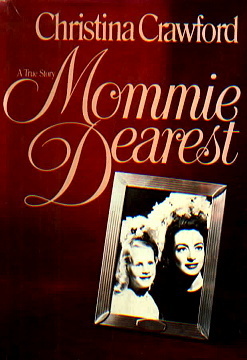 But that wasn’t the end of the Crawford story, for revenge is sweet. In 1978 her daughter Christina published her memoir and exposé Mommie Dearest, whose allegations of physical and mental abuse to her and her brother Christopher fired a broadside into the Crawford legend. Crawford was depicted as a raging alcoholic who adopted children for publicity purposes, who was more concerned with her career than with her children, and who had countless affairs with both men and women. According to Christina, on one occasion her mother even tried to strangle her. A host of Crawford’s friends and coworkers, including Van Johnson, Marlene Dietrich, Myrna Loy, Katherine Hepburn, and many others, denounced the book, but others, including Betty Hutton, Helen Hayes, and June Allyson, confirmed the charges, claiming to have witnessed the abuse. Crawford’s two younger children stated that they had never experienced any abuse, but their brother Christopher confirmed his sister’s account. A bestseller, the book was made into a 1981 film with Faye Dunaway as Crawford. I suspect that everyone involved was telling the truth: Crawford was a complicated woman with many sides to her personality, so that some people saw one side and others another. And Christina today? Have run through her book and film profits and slowly recovered from a stroke, in the 1990s she was running a bed and breakfast in Idaho, and from 1999 on has worked as a special events manager in an Idaho casino.
But that wasn’t the end of the Crawford story, for revenge is sweet. In 1978 her daughter Christina published her memoir and exposé Mommie Dearest, whose allegations of physical and mental abuse to her and her brother Christopher fired a broadside into the Crawford legend. Crawford was depicted as a raging alcoholic who adopted children for publicity purposes, who was more concerned with her career than with her children, and who had countless affairs with both men and women. According to Christina, on one occasion her mother even tried to strangle her. A host of Crawford’s friends and coworkers, including Van Johnson, Marlene Dietrich, Myrna Loy, Katherine Hepburn, and many others, denounced the book, but others, including Betty Hutton, Helen Hayes, and June Allyson, confirmed the charges, claiming to have witnessed the abuse. Crawford’s two younger children stated that they had never experienced any abuse, but their brother Christopher confirmed his sister’s account. A bestseller, the book was made into a 1981 film with Faye Dunaway as Crawford. I suspect that everyone involved was telling the truth: Crawford was a complicated woman with many sides to her personality, so that some people saw one side and others another. And Christina today? Have run through her book and film profits and slowly recovered from a stroke, in the 1990s she was running a bed and breakfast in Idaho, and from 1999 on has worked as a special events manager in an Idaho casino.Crawford was certainly an imperious and demanding presence who reveled in stardom and managed to project and sustain it even after leaving Hollywood. Quite a contrast, then, with some of the other Hollywood celebrities who ended up in New York.
Greta Garbo
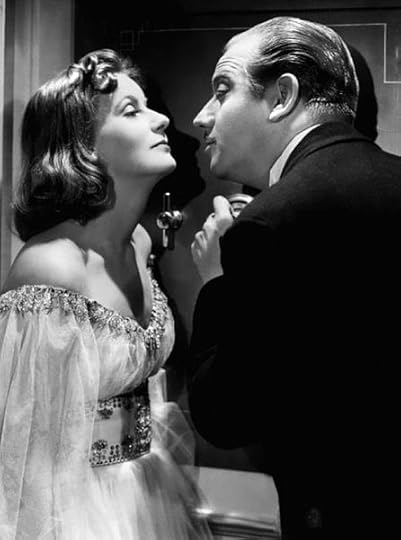 With Melvyn Douglas in Ninotchka. If Crawford loved stardom, the Swedish-born Garbo came to shun it. As a kid growing up in the thirties, all I knew of her was her famous utterance in Grand Hotel, “I want to be alone” (usually quoted with a fake accent: “I vant to be alone”), though she later insisted that off the screen she had said, “I want to be let alone.” Her performances in both silent films and talkies were praised for their subtle, understated quality; with her eyes alone she could express a wide range of emotions. I have seen her in Anna Christie (1930), which I didn’t think quite worked, and in Camille (1936) and the comedy Ninotchka (1939), which did.
With Melvyn Douglas in Ninotchka. If Crawford loved stardom, the Swedish-born Garbo came to shun it. As a kid growing up in the thirties, all I knew of her was her famous utterance in Grand Hotel, “I want to be alone” (usually quoted with a fake accent: “I vant to be alone”), though she later insisted that off the screen she had said, “I want to be let alone.” Her performances in both silent films and talkies were praised for their subtle, understated quality; with her eyes alone she could express a wide range of emotions. I have seen her in Anna Christie (1930), which I didn’t think quite worked, and in Camille (1936) and the comedy Ninotchka (1939), which did.In spite of her remarkable talent, and her luminous and haunting beauty, and the phenomenal salary she received, in 1941, at age 35, she retired from films. After that she received many offers of films, but in the end rejected all of them. She didn’t give her reasons for retiring, but she was aware of beauty’s perishability, had always avoided Hollywood parties and Oscar ceremonies, gave few interviews, signed no autographs, and late in life said that she had grown tired of Hollywood, disliked her work there, and wanted to live another life.
In 1951 she became a U.S. citizen, and in 1953 she bought a seven-room apartment at 450 East 52nd Street where, alone, she would live for the rest of her life. From her large, sun-filled living room she had a sweeping view of the East River, whose traffic she loved to watch. Fond of art and antiques, she had several Renoirs, other paintings, two Louis XV fauteuils flanking the fireplace, and some Chinese porcelain boxes. She once told a friend, “I love color. I want the room to sing.” And sing they did, all her rooms, since she surrounded herself with vibrant hues. But few people ever saw them, only those who worked with her to decorate the rooms, and a few chosen friends whom she invited.
Certainly she craved solitude and could be reclusive, but contrary to stories told about her, she always had many friends and acquaintances. But if she jet-setted, as she occasionally did, she still guarded her privacy, using aliases and booking two seats so as to have no one next to her. With time she became very close to her longtime cook and housekeeper, who later remarked, “We were very close – like sisters.” At age 60, to a friend Garbo once mentioned “the sorrow that never leaves me, that will never leave me for the rest of my life.” And to another she confessed, “I suppose I suffer from very deep depression.” It has been suggested that she was bipolar, alternating quickly between happiness and despair.
One of her favorite activities was long daily walks in the East 50s and 60s in Manhattan, where she browsed in wine, antique, and health food stores, or even walks down to Washington Square and back, alone or with a companion, without makeup, dressed casually and wearing large sunglasses. She loved to smell bread being baked in a bakery, observe what shop girls were wearing, or catch bits of a couple’s argument at an outdoor café. “Garbo watching” became a popular pastime for photographers, fans, and neighbors, for whom Garbo, long retired and elusive as ever, still maintained her mystique.
She never married, had no children. Though she had had affairs with men – silent film star John Gilbert and conductor Leopold Stokowski among others – she may have been bisexual and had affairs with women as well, though this is not certain; if true, it simply adds to her legend.
Neighbors said that she seemed to be in good health until the last year before her death. She died in a New York hospital of pneumonia and kidney failure on April 15, 1990, at age 84. She was cremated here and her ashes were buried in a cemetery near her native Stockholm in Sweden. A successful investor in stocks and bonds, she left her estate of $32 million to a niece.
Gloria Swanson
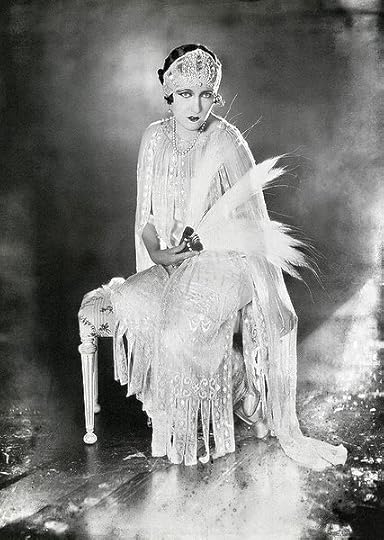 Swanson in 1921. From the wild days of
Swanson in 1921. From the wild days ofsilent film. She was a great star of silent films and a fashion icon of the Roaring Twenties, photographed often in startling hats and an abundance of furs, while her many marriages – none of them except the final one lasting – created headlines and titillation. As for extra-marital adventures, her affair with Joseph P. Kennedy, the patriarch of the Kennedy clan, was an open secret in Hollywood for years. Though she made the transition into talkies, her film career was fading and in 1938 she moved to New York City to launch a post-Hollywood career.
In New York City she founded Multiprizes, an inventions and patent company committed to rescuing Jewish scientists and inventors from war-torn Europe and bringing them to the U.S. She made stage and TV appearances, took up painting and sculpture, wrote a syndicated column, and became seriously involved in designing and marketing clothing and accessories. A film has-been, if you like, but not one to fade into the shadows, being active on many fronts. Then, in 1950, she achieved stardom again as the faded silent film star Norma Desmond in Billie Wilder’s much acclaimed Sunset Boulevard, though Desmond, delusional and living in the past, was the very opposite of Swanson herself. Mae West, Mary Pickford, and Pola Negri had all turned down the role, before it was offered to Swanson, who was nominated for an Oscar but lost out to Judy Holliday in Born Yesterday.
What I find most interesting about Swanson is not her brilliant comeback in film, but her dedication to healthy living and especially healthy food. In 1927, while still involved in films and immersed in the entanglement with Kennedy, she consulted a doctor about possible ulcers; the doctor asked her what she had eaten the night before, then had her imagine all that food in a pail and tell him what animal, pigs included, would eat it. As she told it, she became a “health food nut” then and there.
For the rest of her life Swanson was that rarity among celebrities, one that neither smoked nor drank, a supposed eccentric who campaigned for healthy living. An early advocate of a macrobiotic diet, raw food, and yoga, she only steamed her oatmeal and grains so as to preserve nutrients. Shunning tap water, she drank spring water from France, made sugar by boiling organic raisins, and fasted frequently. Later in life she would attribute her longevity to good nutrition and avoidance of junk food, and denied she had ever had plastic surgery. “Nose, teeth, bosom, hair, kidneys – everything but the eyelashes – is real.”
But to truly achieve the status of health nut and eccentric required more than this, and she went all the way. Garbed in a turban with ostrich feathers and sparkling with diamonds, she was quite capable of chastising strangers on the street for eating junk food, and brought brown bag lunches and a thermos of soup to the jet-setting events she attended. The young nutritionist Gary Null, just starting out in the nutrition field, heard her harangue against the dangers of the sugar-rich American diet and immediately recognized in her a pioneering ally meriting recognition and the highest praise. Not that Americans were easily persuaded. It is even said that someone who detested her sent her a baby casket filled to the rim with sugar. “Why do people treat their bodies like garbage pails?” she once asked, her blue eyes flashing. “I sound like a broken record. Now I just tell people to go ahead and eat ground glass if they want. See if I care.”
At a press conference in the 1960s, upon seeing a chubby young journalist named William Dufty drop a sugar cube in his coffee container, she announced, “That stuff is poison. I won’t have it in my house, let alone in my body!” Ten years later, trim and slim, he looked her up at her Fifth Avenue apartment to thank her for changing his life, and they talked in the kitchen until 1:00 a.m., bound by a mutual loathing of sugar and a desire to convert Americans to a healthier diet.
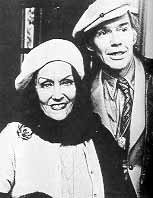 Swanson and Dufty. In 1975 Dufty published Sugar Blues, a best-seller denouncing refined sugar or sucrose as a threat to health and comparing it to opium, morphine, and heroin – allegations passionately denied by what Dufty termed “sugar-pushers,” including the makers of such quintessentially American concoctions as Coca-Cola and Pepsi-Cola. (Swanson vs. Crawford, healthy living vs. Pepsi – what an epic battle that would have been! But so far as I know, they never crossed swords.) In 1976 Dufty and Swanson married because, as she put it, “We totally understand each other. Besides, my life is one surprise after another.” It was his second marriage and Swanson’s sixth and final one, which lasted until her death; he was 60, she was 76 and a grandmother. They were soon busy on a nationwide tour promoting his book. From then on he served her as cook, advisor, and muse, ghostwriting her 1981 autobiography, Swanson on Swanson.
Swanson and Dufty. In 1975 Dufty published Sugar Blues, a best-seller denouncing refined sugar or sucrose as a threat to health and comparing it to opium, morphine, and heroin – allegations passionately denied by what Dufty termed “sugar-pushers,” including the makers of such quintessentially American concoctions as Coca-Cola and Pepsi-Cola. (Swanson vs. Crawford, healthy living vs. Pepsi – what an epic battle that would have been! But so far as I know, they never crossed swords.) In 1976 Dufty and Swanson married because, as she put it, “We totally understand each other. Besides, my life is one surprise after another.” It was his second marriage and Swanson’s sixth and final one, which lasted until her death; he was 60, she was 76 and a grandmother. They were soon busy on a nationwide tour promoting his book. From then on he served her as cook, advisor, and muse, ghostwriting her 1981 autobiography, Swanson on Swanson.Back in 1994, when I was doing volunteer work for the Whole Foods Project (see vignette #8, 5/20/12), I met William Dufty, though I had no idea at the time that he had been Swanson’s last husband. He spoke to us with conviction about the dangers of sugar, which he considered more poison than food, telling us how he had been literally addicted to it and experiencing “sugar highs” followed by depression. To illustrate his point, he posed for a photographer while dumping a large quantity of sugar from a container into a trash can. Then he had us all sign his white shirt in a gesture of solidarity. He was charming, passionate, and quite convincing. (I myself needed no convincing; I had already emptied my apartment of the stuff, and it remains void of sugar – the white stuff found on lunch counters everywhere – to this day.)
 In her New York apartment in 1972.
In her New York apartment in 1972.Allan warren By the 1970s Swanson was dividing her time between homes in Manhattan, Beverly Hills, and Portugal. In New York her elegant ground-floor apartment at 920 Fifth Avenue, between 72nd and 73rd Street, where she had lived since 1938, had a green baby grand piano, a mirrored green fireplace, and French Provincial furniture scaled down to her diminutive size, she being only 5 foot 1 in height. French doors opened into a rear garden, a glass-covered alcove housed the dining room, and adjoining the living room was an office where two secretaries could attend to her many business and professional interests. Like most of these Hollywood girls who came to New York, she was living high on the hog.
Prominent socialites, Swanson and Dufty often traveled together here and abroad. While promoting Sugar Blues they met ex-Beatle John Lennon and his wife Yoko Ono, and Swanson testified on Lennon’s behalf when he applied to become a permanent resident of the U.S., which he finally did in 1976. Returning to New York from her home in Portugal, Swanson was hospitalized with a heart ailment and died in her sleep there on April 4, 1983, at age 84. She was cremated and her ashes were interred at the Episcopal Church of the Heavenly Rest on Fifth Avenue. She had sold her archives to the Harry Ransom Humanities Research Center at the University of Texas at Austin. Her husband then returned to his home state of Michigan, where he died in 2002.
Rita Hayworth
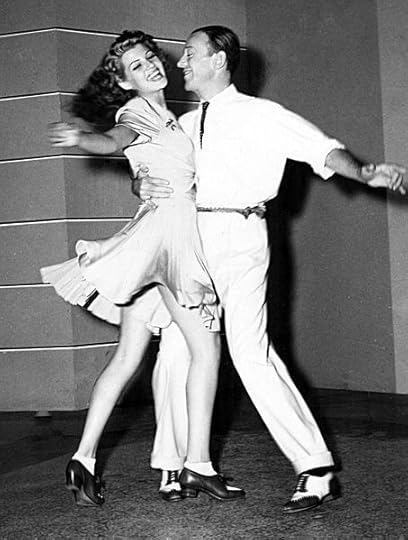 Hayworth and Astaire in You Were
Hayworth and Astaire in You Were Never Lovelier, 1942. We knew her as Fred Astaire’s dancing partner after Ginger Rodgers left the act; during the war as a luscious GI pinup in a black-lace negligee who seemed to just beg you to go to bed with her; as a top glamor girl and love goddess of the 1940s, her face on the cover of Life magazine five times; the femme fatale who did a legendary striptease in Gilda; and as the Hollywood princess who married Ali Khan, the playboy son of the Aga Khan, the fabulously wealthy imam of a Muslem sect in India whose followers every year gave him his weight (and he wasn’t slender) in diamonds and gold. She was crimson-lipped, enticing, and stunningly beautiful.
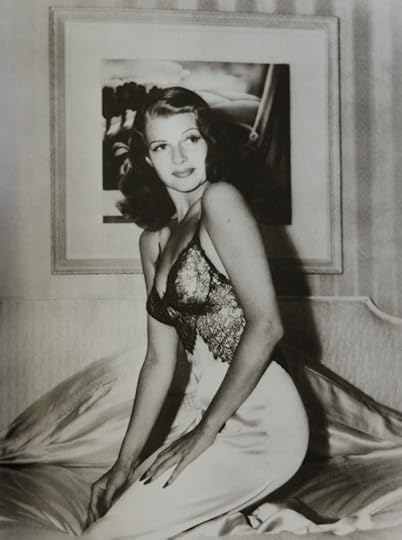 No question, she helped win the war.
No question, she helped win the war.When she came to New York in 1981, her film career long over, she was a different person, sadly changed. Career pressures had long since led to alcoholism, outbursts of rage, and erratic behavior, and she had prematurely aged. (I’ve seen a photo of her in later years, her face ravaged and creased with wrinkles; I haven’t the heart to reproduce it here.) In 1980 she was diagnosed with Alzheimer’s, and by 1981 her dementia had progressed to the point where a judge in Los Angeles ruled that she should be placed in the care of Princess Yasmin Khan of New York City, her daughter by Ali Khan. She spent her last days in an apartment at the San Remo, a luxury co-op apartment building between West 74thand 75th Streets on Central Park West, where her daughter, who lived in the apartment next door, looked after her until the end. In February 1987 she lapsed into a semicoma and died of Alzheimer’s complications on May 14 of that year. Her funeral in Beverly Hills was attended by celebrities who had known her, and President Reagan hailed her as “one of our country’s most beloved stars.”
A sad ending. Was her life sad as well? For all the fame and glamor, it would seem so. “I naturally am very shy,” she once confessed, “and I suffer from an inferiority complex.” “Men fell in love with Gilda,” she also said, “but they wake up with me.” There was no triumph in her post-Hollywood life, only a sad and at times violent decline. When she was diagnosed with Alzeimer’s, her daughter was actually relieved; it explained so much of her mother’s erratic behavior over the past twenty years.
A note on Capoeira: Last Wednesday I went again to the Union Square greenmarket, where I bought some goat cheese seasoned with chives, and then went on to Astor Liquor for some bargain wines, and came back on West 4thStreet passing Sheridan Square, where General Sheridan stands nobly and very martially, seemingly unperturbed by the life-size sculpted figures of two same-sex couples, one male and one female, that now grace his square. But before I got to the square I stopped off for a few minutes in Washington Square Park. There, over near the fountain, was a crowd of 30 or 35 young people, probably New York University students, standing in a ring, with some dancers dancing wildly in the center. The crowd was singing, almost chanting, and clapping rhythmically as the dancers performed wild gyrations and acrobatics. How can they keep it up? I wondered, since sooner or later even twenty-somethings have to catch their breath.
Going nearer, I found the answer: at intervals some dancers retired to the sidelines, and others from the crowd joined the dance. I say “dance,” but it was dancing and gymnastics and martial arts all rolled into one, with the performers in motion every second, leaping and bending and spinning about, and at moments, when another ducked down, raising one leg over the other dancer’s back. Sometimes they seemed like opponents, yet no one was touched, and everyone was smiling and it was all in good, albeit strenuous, fun. Leading the singing were several young men and women all in white, their T-shirts inscribed “Capoeira Luanda / mestre jalon,” which, since it wasn’t quite Spanish, I took to be Portuguese. These leaders sometimes joined in the performance, even standing momentarily on their head or turning cartwheels or walking on their hands to enthusiastic cheering and applause. But the students who also joined in were so deft and nimble that they must have practiced this before. And all the while the spectators were singing and clapping rhythmically, though there were no musical instruments and no recorded music, just voices singing. Never having witnessed such a performance before, I lingered longer than I meant to. And just as I finally left, the leaders motioned the spectators in, so that they crowded into the center for more singing and clapping. Impressive, but what was this all about?
 Capoeira in France.
Capoeira in France.Marie-Lan Nguyen
Back in my apartment I found the answer on the Internet. Capoeira is an Afro-Brazilian art form that indeed blends martial arts, dance, and acrobatics. It was created in Brazil by slaves from Africa who disguised the martial arts aspect as dance, so as not to alarm their masters when they performed it openly. Today it is known and practiced throughout the world, Capoeira Luanda being an organization in New York that offers group and private classes, some of them taught by the well-known Mestre (Master) Jelon (though the T-shirts said Jalon). Luanda is the capital of Angola, a former Portuguese colony in South Africa and the third biggest Portuguese-speaking city in the world.
My take-away: New York City is inexhaustible. Just take a walk or sit in a park and you will see marvels.
A note to the note: While sitting in Washington Square Park near the fountain, I was reminded of a recent bit of municipal lore. In spite of considerable opposition, the city decided to move the fountain so as to align it with Washington Square Arch, which rises grandly in the park at the foot of Fifth Avenue. It took many months, during which much of the park was disrupted. How much was the fountain moved? All of 22 feet. The cost? $30 million. No further comment is necessary.
This is New York
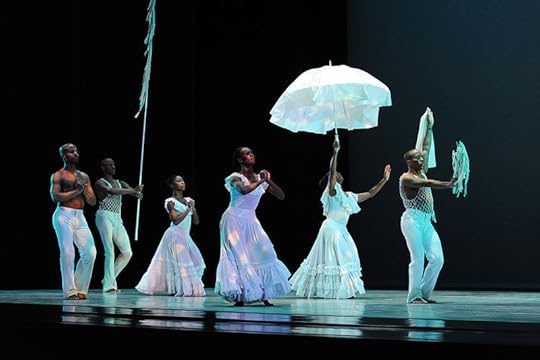 Knight Foundation
Knight FoundationComing soon: Ethnic New York: Sherpas, Basques, Gypsies, Sikhs. You don’t know them? If you’ve hailed cabs in New York City, you have; at one point or another, they were probably your driver.
© 2014 Clifford Browder
Published on May 11, 2014 04:18
May 4, 2014
125. Remarkable Women: Eliza Jumel
This post is the first of two or more about remarkable women who lived for a significant part of their life in New York City. The Morris-Jumel mansion mentioned below is the oldest house in Manhattan and well worth a visit.
Eliza Jumel (1775-1865) was an unusual woman for many reasons, but to get at the truth of her earlier years is a challenge, since she wove many myths about herself. She claimed to have been born of an aristocratic English mother, a Mrs. Capet, in the cabin of a French frigate en route to the West Indies, whose captain, when the mother died in childbirth, delivered the infant into the care of an elderly lady named Thompson in Newport, Rhode Island, where she was raised in humble but respectable circumstances.
Another version has her born in a poorhouse in Providence, Rhode Island, and adopted by a Mr. Bowen, whose name she bore. At age seventeen, yet another story goes, she eloped to New York with a British officer, a Colonel Peter Croix and, being beautiful and charming, was accepted into the society of the time, made the acquaintance of Aaron Burr, Benedict Arnold, Patrick Henry, Benjamin Franklin, and Thomas Jefferson, and witnessed both the first session of the Continental Congress in Philadelphia, and Washington’s inauguration as president. All of which is bosh. If she witnessed the first session of the Congress, she must have done it from the womb. And if she met any of the Founding Fathers, she would have been a babbling infant. There are as many accounts of her origins as there were early biographers, and not one of them can be trusted.
The most commonly accepted account today has her born in Providence in 1775 to Phebe Kelley Bowen, a prostitute, and her sailor lover who died at sea. How she spent her childhood isn’t clear; she may have been taken in by local families or been raised in a poorhouse. She is even said to have worked as a cleaning girl – but not as a prostitute -- in the brothel where her mother worked, and subsequently may have turned to prostitution herself. Certainly it was a rough childhood, and one with meager promise. Little wonder that she later invented a tale about a birth on the high seas to an aristocratic mother who then conveniently died. And little wonder too that she became obsessed with acquiring social status and wealth.
In time Eliza Bowen made her way to New York, perhaps because a prominent citizen of Providence, fearing exposure of their liaison, paid her to leave town. In New York she became an actress and in time a kept woman, neither profession likely to win entrée into polite society. But she was beautiful, and if she lacked formal education she enjoyed a keen native intelligence and therefore aimed high.
In 1804, at age twenty-nine, she married Stephen Jumel, after having lived with him first. Jumel was a wealthy French wine merchant and ship owner of about fifty, originally from a merchant family in Bordeaux, who had made a fortune in cotton, sugar, coffee, and indigo in the French colony of Haiti, before fleeing the 1791 slave revolt there and coming to New York, where he made a new fortune and became the city’s leading merchant in wines, brandies, cordials, and gins. He may have been tricked into the marriage. The story is told that he returned from an absence to find his mistress on her deathbed and desirous of marriage so she could go to heaven a somewhat honest woman. Grief-stricken, Jumel agreed and a civil marriage was performed, following which his new wife recovered amazingly. As a good Catholic, Jumel then had a second marriage performed in the Catholic cathedral of the time.
Now that she had the means, the new Madame Jumel surely dressed in the height
 The Empire style dress of the early 1800s.
The Empire style dress of the early 1800s.Not Madame Jumel; I have had no access
to any image of her in her youth.of fashion, which meant the high-waisted gowns made fashionable by the Empress Josephine in France, since New York society was quick to follow the latest Parisian styles. And thanks to her husband, she had a fine carriage to parade about in. But wealth and fine clothes and a carriage didn’t mean that Eliza Jumel was accepted by society. The city was still small enough for everyone to know, or know of, everyone else, their family and the source of their wealth. Even if she hadn’t been an actress or a kept woman, Eliza Bowen was an unknown, her background questionable. That Stephen Jumel married her anyway was her great good luck.
In 1810 Jumel bought what would then become known as the Jumel mansion in Upper Manhattan. He and his wife then remodeled and completely refurnished the house, a handsome Georgian-style residence built in 1765 by a British officer, Colonel Roger Morris, as a summer villa eleven miles north of the city. At the outbreak of the Revolution the colonel and his wife, being loyal to the Crown, fled the city, and George Washington made it his headquarters in 1776, before abandoning the city to the British. After the war the vast Morris estate was confiscated and became farmland, and the house, briefly, a tavern. When Jumel acquired it, it was still far north of the settled part of Manhattan, a 65-acre rural retreat on high ground affording a fine view to the east of the Harlem River, and to the west of the Hudson and New Jersey. There, amid elegant French Empire furnishings, both he and his wife would live much of the rest of their lives, and with them a niece of hers (some say an illegitimate daughter) whom they adopted at an early age.
 Elisa Rolle
Elisa RolleIn 1815 – whether before or after Waterloo is unclear – the Jumels and their adopted daughter sailed on one of his ships to Bordeaux, because the husband wanted to visit relatives there. Stephen Jumel was an enthusiastic supporter of Napoleon, and it is even said that when the Emperor suffered his final defeat at Waterloo, the Jumels offered him safe passage to America, an offer he chose to decline. Though the Jumels went on to Paris, stories of Eliza's dazzling the imperial court are not to be trusted, since the Emperor was on his way out when they arrived in Paris, nor would she, as a Bonaparte sympathizer, have been welcome in the court of the restored Bourbon king, Louis XVIII. But she may well have muted her Bonaparte sympathies so as to make inroads into Restoration society -- the society described so vividly by Balzac -- and seems to have indeed made the acquaintance of some of the French nobility, whether Bonapartist or otherwise, and from them perhaps received some Napoleonic mementos. The story that Louis XVIII expelled her from France because of her political opinions seems doubtful, since if he expelled the wife, why not the husband too? It could well have been a quarrel with her husband that sent her back to America alone.
Eliza Jumel returned to New York in 1817, but her husband and daughter remained in France, the daughter being in boarding school there. The daughter later returned, but in 1821 she and Eliza Jumel went back to Paris and stayed for several years, renewing the mother's contact with the French nobility, before returning in 1826, at which time Eliza Jumel was armed with a power of attorney allowing her to manage Stephen Jumel’s affairs in New York; he evidently planned to remain in France and wanted her to sell his property and rejoin him in France, which she failed to do. When Stephen Jumel returned to New York in 1828, he was shocked to learn that his wife had deprived him of all his property by conveying it to a trustee, but they reached a settlement whereby they would all live together in the mansion until he died, his wife being his heir, with the adopted daughter to inherit at Eliza Jumel’s death.
While in France Eliza Jumel had certainly become fluent in French and acquired polished manners, a veneer of sophistication, and a renewed interest in Empire-style furnishings. Back in America, she reestablished herself in the mansion and furnished it with bric-a-brac, laces, and fine furniture that she had bought in Paris. In the years that followed she and her husband are said to have entertained lavishly, their guests including Joseph Bonaparte, the Emperor’s older brother and former king of Spain, who established himself for many years on a large estate in New Jersey, and Louis Napoleon, the future Emperor Napoleon III, who came to this country for a brief visit in 1836. The Bonaparte clan obviously did not share New York society’s suspicion of Madame Jumel.
The Jumel mansion is now open to the public and I visited it recently. A frame structure that has miraculously escaped the ravages of fire, it is still surrounded by ample high grounds shaded by maples and elms. Its façade features an imposing portico with four columns topped by a triangular pediment, and most of the interior is furnished in French Empire style, with discreet carving and gilding, a style that strikes me as light, elegant, and modern, as opposed to the heavier, overstuffed furnishings of the Victorian age.
In her early years in the house, one can well imagine the hostess, in a high-waisted, low-necked Empire gown, her arms bare, her throat adorned with a string of pearls, gliding down the ample entrance hall to receive arriving guests and wave them into the octagonal drawing room in back. The gilded eagles topping the wide, arched doorways of the hall would have warmed the heart of any Bonaparte or Bonaparte supporter, since Napoleon’s armies went into battle with standards topped by a gilded eagle, an emblem so closely identified with the Emperor that Louis XVIII ordered their destruction.
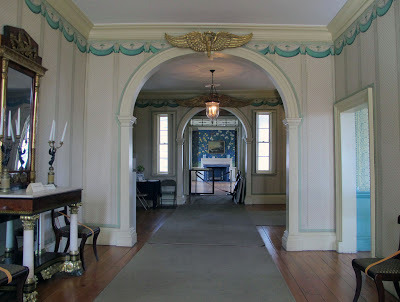 The front hall, looking toward the drawing room in back.
The front hall, looking toward the drawing room in back.Gilded eagles over the doorways. Or we can imagine Madame, now in the ampler gown fashionable by the 1830s, chatting with an ex-king or future emperor in the formal front parlor before the large fireplace, its mantel adorned with candles and an ornamental clock, under the massive crystal chandelier. Or waving guests into the dining room across the hall, which today is set with six settings for dessert, with chinaware and sparkling glasses. Or imagine her pointing out to guests a set of chairs that, she assured them, had once belonged to the First Consul, or a clock from the Tuileries, or tapestries and paintings once collected by the Empress Josephine, or a stand that had belonged to Voltaire, or furniture once owned by Charles X, the last of the Bourbons to rule – some of which may even have been true. She is also said to have displayed furniture emblazoned with the imperial “N,” though on my visit I saw no trace of it. She obviously went to great lengths to embellish her own existence with links, some dubious and some perhaps authentic, to monarchy and the great.
 The front parlor.
The front parlor. The dining room.
The dining room.Elisa Rolle Or we can imagine Madame getting herself elegantly together in her dressing room on the second floor, adjoining her Empire-style bedchamber with its soothing green wallpaper, curtains, and upholstery, and handsome bed (too short for us today) backed by a sumptuous gold hanging with, significantly, another gilded eagle at the top. Some of the bedchamber’s furnishings are said to have been acquired in Paris and shipped here, though the claim that the bed itself, eagle and all, was once the Empress Josephine’s might be met with caution. But there is no doubt that the prostitute’s daughter had come a long way; she lived and slept in style. Yet in the house I saw no room that could be called a library, no study with book-lined shelves.
 Her bedchamber.
Her bedchamber.Elisa Rolle
In those days rustic grandeur had its limits. How was the house heated and lighted, how did they bathe, and how were their bodily needs attended to? In the city to the south, gaslight was installed in the 1820s and 1830s, but this required an unsightly, smelly gas works over near the East River or the Hudson, which in the countryside was out of the question. So Madame Jumel’s mansion was lit with whale oil lamps and candles, and heated in every room by a fireplace where wood crackled and sparks danced in the air, to be supplanted later by the steady, warm glow of coal.
And water? While the city, as of 1842, had the Croton water, and affluent middle-class households, by paying a water tax, had running water for cooking and flushing and bathing, country residences lacked such amenities. Somewhere in the Jumel mansion – though nowhere indicated during my visit -- there must have been cubbyholes or closets where the residents could relieve themselves discreetly, and water for cooking and bathing must have come from a well in the neighborhood, though during my visit I neither saw such a well nor heard of one. All of which implies an army of servants not just to clean the rooms and cook the food, and tote the food from the basement kitchen upstairs to the dining room (I saw no dumbwaiter either), but also to fetch wood and coal and water, and to tend the grounds as well. They would have been lodged in the basement, out of sight of the masters, on condition that they appear upstairs whenever needed, which, one suspects, was rather often. Yes, rustic grandeur had its limits. And yet, secure in her mansion on a breezy eminence well removed from the city, Madame was not exposed to the annual summer outbreaks of yellow fever that plagued the lower wards of the city, or the cholera epidemic that struck in the summer of 1832.
On May 22, 1832, shortly before the cholera epidemic, Stephen Jumel was thrown from his carriage (though some sources say a hay wagon) and incurred injuries that proved fatal; being Catholic, he was buried in the churchyard of the old Saint Patrick's Cathedral on Mulberry Street near Prince. It is said that their spousal affection had long since withered, and rumors circulated that she had let him bleed to death, but this too should probably be dismissed as myth. What is certain is that within a year the widow married Aaron Burr, infamous for killing Alexander Hamilton in a duel many long years before.
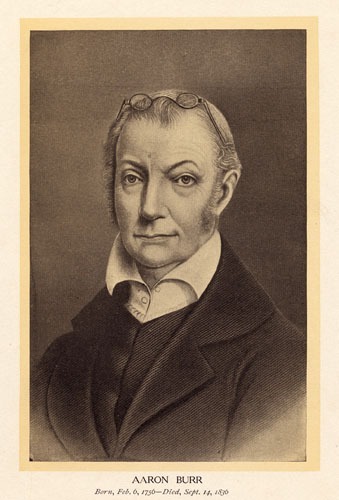 Burr had returned to the city and resumed his law practice, and was known to be especially versed in the law regarding real estate. Madame Jumel, who had evidently known him briefly long before, went to his office in Nassau Street to consult him on such a matter, and he received her graciously, paid close heed to all she said, and then conducted her to her carriage in princely style. Soon afterward Burr took on as a student Nelson Chase, the young husband of Madame Jumel’s niece and adopted daughter, who now lived in the mansion with her and his wife. Burr assured the young man that he would learn more from him in one year than he could learn elsewhere in ten, and so it came about. Chase praised Burr to the skies and persuaded his mother-in-law to invite Burr to dinner. When she did, her courtly guest led her in to dinner, remarking, “Madame, I give you my hand; my heart has long been yours.” After that he called on her often and proposed, only to be turned down.
Burr had returned to the city and resumed his law practice, and was known to be especially versed in the law regarding real estate. Madame Jumel, who had evidently known him briefly long before, went to his office in Nassau Street to consult him on such a matter, and he received her graciously, paid close heed to all she said, and then conducted her to her carriage in princely style. Soon afterward Burr took on as a student Nelson Chase, the young husband of Madame Jumel’s niece and adopted daughter, who now lived in the mansion with her and his wife. Burr assured the young man that he would learn more from him in one year than he could learn elsewhere in ten, and so it came about. Chase praised Burr to the skies and persuaded his mother-in-law to invite Burr to dinner. When she did, her courtly guest led her in to dinner, remarking, “Madame, I give you my hand; my heart has long been yours.” After that he called on her often and proposed, only to be turned down.Always attractive to women, well-mannered, and deft with compliments, the elderly Burr was not one to give up easily. Finally, on July 1, 1833, he showed up at the mansion with a clergyman and proposed again, with her niece and young Chase pleading in his favor. Feeling lonely in her spacious mansion, and seeing the advantage of a husband capable of managing her affairs, after further hesitation the widow agreed, and quickly donned an appropriate gown. The ceremony was performed in the formal front parlor with only her relations present, while the eight servants peered in from the doorway. She was 58, and he an alert and vigorous 77. A merry supper followed, gladdened by some vintage bottles from Stephen Jumel’s wine cellar. The new husband moved in and was given a handsome bedroom across the hall from hers, where the visitor today may see furnishings typical of the 1830s, including a canopied four-poster and bright red curtains and bedding, the bold color contrasting sharply with the gentle green of her room and therefore singularly appropriate. (The room was once designated Lafayette’s bedroom, but no more, and it’s just as well; Lafayette visited the U.S. in 1824-25, but at that time the Jumels were still in Paris.)
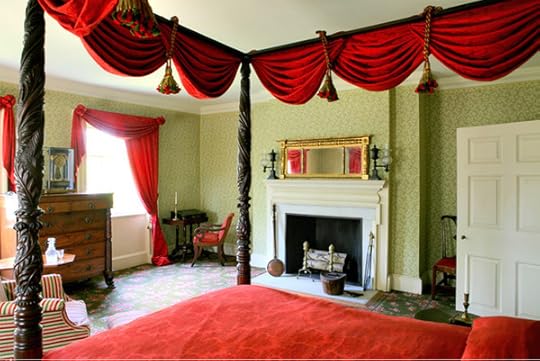 The Aaron Burr bedroom.
The Aaron Burr bedroom.There is little doubt that Burr married her for money, and she may have seen in the marriage a way to climb a bit higher socially. But while Burr was knowledgeable about New York real estate, he was less adept when it came to investing elsewhere, and lost a good hunk of her money in a land speculation in Texas. A certain coolness then settled in between them, with arguments, an attempt at reconciliation, more bad investments and losses, and finally, on her part, a filing for divorce – no small matter, since in respectable society divorce was simply unheard of. But Eliza Jumel had had enough and was determined to rescue her affairs from Burr’s mismanagement. He moved out and she resumed the name of Jumel. Having at first contested the divorce, he finally acquiesced in it. The divorce became final on September 14, 1836, the very day when Burr, residing by then in a boarding house on Staten Island, died. Ever eager to annex a bit of grandeur, after that Madame Jumel is said to have presented herself, when traveling, as “Mrs. Aaron Burr, widow of the Vice President of the United States.” He was of more use to her dead than living.
Her rejection by Knickerbocker society did not keep the widow Jumel from joining the annual exodus of New Yorkers north to Saratoga, where drawling planters and their wives fleeing the torrid heat of the South rubbed genteel elbows with the moneyed chivalry of Gotham. At first she stayed in the sumptuous United States Hotel, the resort of New York’s wealthy, but in 1851 she bought a handsome Greek Revival house fronted by soaring square white columns on Circular Street and spent her summers there over the following years. A stranger to modesty, she named her residence the Tuileries after the Parisian palace where she claimed to have stayed as a guest, and wore diamonds that had allegedly once belonged to the Empress Josephine. But for all her obsessive social climbing, she was still a shrewd businesswoman and bought several farms in the area where she grew vegetables for the Saratoga hotel and restaurant trade.
Her annual treks to and from Saratoga in a bright yellow carriage drawn by four horses along the Albany Post Road are said to have become a tradition that drew crowds to the roadside to watch. I find it questionable, though, that she would have subjected herself and a carriage meant for gentle urban usage to the rigors of a long trip over an unpaved, bumpy road, when the preferred way to get to Saratoga was by steamboat to Albany and then a short trip there by stage.
But while in Saratoga she certainly paraded about in the carriage, to the bedazzlement of some and the annoyance of others. It was no small achievement that she made it a tradition that the afternoon parade of carriages out to Saratoga Lake and back, a pageant much noted and observed, should be led by none other than herself in that same blatantly yellow carriage, during which she bowed and waved to the crowds with an ostrich-feather fan in a gesture of noblesse oblige. In democratic America this could not go unchallenged. One day during the procession, being greeted with smirks and laughter, she finally looked back and discovered that following behind her was just a single carriage, and in it a black man in female garb mimicking her regal gestures to the crowd, a farcical performance that continued all the way to the lake and back. Her mimic could not have acted alone; one suspects a conspiracy by respectables to put the upstart in her place. When she entered her carriage the next day, it is said, she deposited a pair of pistols on the seat beside her.
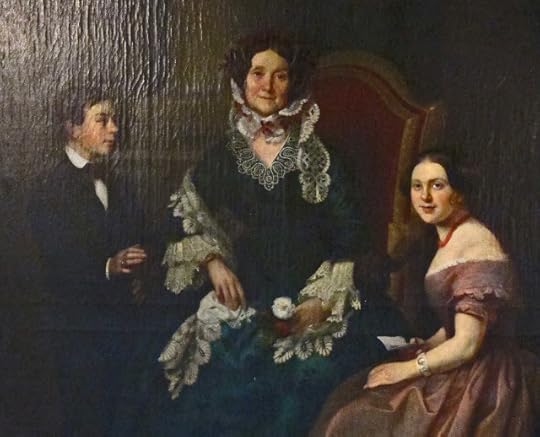 Eliza Jumel and her grandchildren. A painting of 1854.
Eliza Jumel and her grandchildren. A painting of 1854.Eliza Jumel continued to live in her New York mansion with her niece and Nelson Chase, and in time with their two children, though she seems also to have lived at times in the city. In 1852, at age 77, she made a visit to Paris, where Louis Napoleon, now President of the Republic but not quite Emperor yet, gave a ball where she entered on the arm of Jerome Bonaparte, yet another of that clan of ex-kings. Mindful of her kindnesses to him in former years, the President extended many courtesies to her. Two years later she took her two grandchildren on a grand tour of Europe, during which their portrait was painted in Rome; how she was received in Paris, where Louis Napoleon now reigned as Napoleon III, seems not to be recorded. Back home in her mansion, she is said to have lived quietly, having a small circle of friends and not desiring to have any more. But there are also stories of eccentricity and maybe even insanity in her last years, with her seated on a thronelike dais in the drawing room and receiving all manner of distinguished imaginary guests. She died in the mansion in 1865, at the age of 90, and was buried not with her husband, as is sometimes stated, but in a vault in Trinity Church Cemetery in Upper Manhattan. Following her death a George W. Bowen surfaced who claimed to be her illegitimate son, born of an early liaison in Providence, and therefore the heir to her estate. After a long battle in the courts his claim was denied, and Nelson Chase, now a widower, and his two children inherited most of her estate.
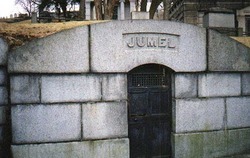 Her vault in Trinity Church Cemetery.
Her vault in Trinity Church Cemetery.Such was the life of Eliza Bowen Jumel, insofar as I have been able to reconstruct it, a life so encrusted with legend, some of her own creation and some concocted by others, that you have to chip and poke and pry so as to get down to a small hard core of facts. What is certain is that she married Stephen Jumel and went to France; that New York society viewed her with suspicion; that she owned considerable real estate in New York and Saratoga; that as a widow she married Aaron Burr and then divorced him; and that she refurnished her mansion and lived in it until her death there in 1865. Beyond these solid facts one has to move with caution.
Assuming that my account is basically accurate, what can one conclude? The prostitute’s daughter had indeed come a very long way. To have presided over a handsome old house with a team of servants on a breezy eminence; to have embellished that house with splendid Empire décor, and slept in a bed of allegedly imperial provenance; to have managed her affairs with competence and shrewdness; and to have hobnobbed with ex-kings and a future emperor – all this, in the face of rejection by polite society, was no small achievement. Feminists embrace her today, myths and all. She had serious flaws, but yes, she was a remarkable woman.
On silence and trees: Followers of this blog know how I value silence (post #55) and trees (#71). The tree of the moment is the redbud. If in a park you see a small tree with red buds, or those buds opening into tiny pink flowers that line every branch and twig with hardly a leaf in sight, that surely is a redbud. Not every park has redbuds, but the little park across the street from my apartment building at the corner of Bleecker Street and West 11th has no less than five. Once the flowers are gone and only the leaves remain, the redbud will simply be another nice little tree, nothing more. So enjoy it now in all its vernal splendor.
Visitors from suburban or rural areas may wonder what New Yorkers know about silence, but we prize it precisely because we have so little of it. I have just learned of the closing of Mount Manresa, a 15-acre Jesuit retreat center on Staten Island that residents of the neighborhood, both Catholic and non-Catholic, valued for many years as a refuge from the workaday world and a place of meditation and prayer. A year ago, when the New York Province of the Society of Jesus announced that, because of declining retreat activity, it was selling the property for $15 million to a developer who planned to build 250 townhouses on the site, the neighbors fought hard to block the sale through litigation. They failed, and the wreckers came during Easter week and in three days felled scores of trees, including a black tupelo thought to be 400 years old. Witnessing this destruction, the protesters screamed and wept; for them, the ground was sacred. Though I have often hiked on Staten Island, I never visited Mount Manresa or even knew of it, but I join the protesters in mourning its loss. It had both trees and silence; for me too, the ground was sacred.
This is New York
 David Shankbone
David ShankboneComing soon: More famous deaths, featuring Pepsi-Cola, a loathing of sugar, and “I vant to be alone”; and a post on ethnic New York: Sherpas, Basques, Gypsies, and Sikhs, with a quick glance at Uzbeks and Tatars.
© 2014 Clifford Browder
Published on May 04, 2014 04:53
April 27, 2014
124. Exiles in New York, part 4
This is the fourth and last post about exiles in New York. It deals with some who came here as a result of Hitler’s rise to power in Germany and the Fall of France.
Strife among the Gauls in exile
In the lobby of a New York hotel, during World War II, the well-known French playwright Henri Bernstein, upon encountering fellow French exile André Maurois, slapped him twice -- once, he said, as a Frenchman, and once as a Jew. “I shall pulverize you,” Bernstein reportedly warned Maurois. “I know how to hate. I shall ruin you. I shall isolate you. I shall reduce you to a position of helplessness.” Such were the threats of one noted French author against another, the two of them wartime refugees in New York, and both Jewish. Nor was Bernstein’s an idle threat. He quickly launched a barrage of attacks on Maurois in the French-language press of the U.S. and Canada, and spread rumors that Maurois was a Vichy sympathizer, a fascist, a foe of the British, and an anti-Semitic Jew. What was this all about?
The collapse of France in the spring of 1940 had brought the end of the Third Republic and the installation, in that part of France not occupied by the Germans, of the right-wing Vichy regime, with Marshal Philippe Pétain, a venerable hero of World War I, as its head. But even as the Vichy government told the French they must adjust to German hegemony in Europe and, in effect, make nice with Hitler, General Charles De Gaulle had launched the Free French movement in Great Britain so as continue the war against Germany. Every French citizen – and above all the intellectuals, to whom many looked for guidance -- had to choose between Vichy and De Gaulle, the newly established regime and the rebel. This conflict could assume a ferocity even among the French exiles in New York.
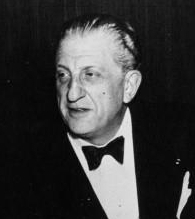 Henri Bernstein For Bernstein, coming to the U.S. was easy: his mother was American, he had wealthy in-laws here, he spoke English fluently and had visited here often. And getting out of France was necessary, since he was Jewish. Only days after the Germans marched into Paris in June 1940, he left for England and sailed from there to New York. Over here he lived sumptuously in the Waldorf Astoria, with a sampling of his art collection on the walls, including a Manet painting and a Toulouse-Lautrec drawing. A notorious womanizer, he took up with Eve Curie, the daughter of the Curies of radium fame, and then with a popular singer. But when it came to politics and the war he was a passionate supporter of De Gaulle, on whose behalf he wrote articles for the New York Times and New York Herald Tribune and other leading newspapers. After the war he returned to France and continued writing plays until his death in 1953.
Henri Bernstein For Bernstein, coming to the U.S. was easy: his mother was American, he had wealthy in-laws here, he spoke English fluently and had visited here often. And getting out of France was necessary, since he was Jewish. Only days after the Germans marched into Paris in June 1940, he left for England and sailed from there to New York. Over here he lived sumptuously in the Waldorf Astoria, with a sampling of his art collection on the walls, including a Manet painting and a Toulouse-Lautrec drawing. A notorious womanizer, he took up with Eve Curie, the daughter of the Curies of radium fame, and then with a popular singer. But when it came to politics and the war he was a passionate supporter of De Gaulle, on whose behalf he wrote articles for the New York Times and New York Herald Tribune and other leading newspapers. After the war he returned to France and continued writing plays until his death in 1953.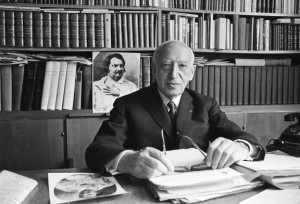 André Maurois, with a picture of Balzac on the
André Maurois, with a picture of Balzac on thewall behind him. And Maurois? Also a Jew (he was born Emile Herzog), he had done liaison work with the British army in World War I, making many British friends, and had lectured in the U.S. and as a result entertained a very positive feeling for the U.S. and its citizens. In 1938 he was elected to the Académie Française, an honor coveted by some and scorned by others among the French intelligentsia. Then, in June 1940, before the Germans entered Paris, the French army sent him on a mission to England, where De Gaulle tried to enlist him as a propagandist addressing the French from London. He declined, fearing for the safety of his family back in France, but also out of loyalty to Pétain, for whom he felt respect and affection. Instead, now demobilized, he accepted an invitation to give lectures in the U.S. and set sail with his wife for New York, where the managers of posh hotels, knowing him from previous visits, were glad to welcome him, assuring him he needn’t worry about paying until he had earned some money in America. He and his wife stayed first at the Plaza, and then in a small apartment on the 17th floor of the Ritz Towers. Invitations for weekends in the country followed. As I have noted before, it pays to have connections, and Maurois had many.
But comfy living was no defense against Bernstein’s attacks. When Maurois wrote an article for Life magazine stressing how the French loved Pétain and asserting – sincerely, no doubt, but erroneously – that the Marshal’s more controversial measures had been taken under duress, it could only have stoked Bernstein’s anger and intensified his hostility. Hence the two slaps in the hotel lobby, and the outpouring of threats and hate. Maurois was by nature a moderate who could see more than one side to an issue, and in wartime moderates are not in great demand.
Though deeply hurt by Bernstein’s attacks, Maurois lectured extensively throughout the U.S., stressing the menace of Nazi Germany to an America that was still technically neutral, and trying to convince skeptical audiences that France’s collapse was the result only of military inadequacies, and not of moral decadence, corruption, and defeatism. In New York he socialized widely with Saint-Exupéry, Romains, and other French refugees, and numerous American friends as well, and even had a chat with Eleanor Roosevelt, who appreciated the positive effect of his lectures.
When the U.S. entered the war, Maurois played a more active role in the struggle, going with his friend Saint-Exupéry to join the Free French forces in North Africa, though what he did there isn’t clear. After the war he rejoined his wife in New York, taught French literature at the University of Kansas City, Missouri, where he imparted to the children of those middle regions, so rich in corn and hogs, the glories of Proust and Balzac. When he returned to Paris in 1946, he found that his apartment on the Boulevard Maurice Barrès had been occupied by the nephew of Herman Goering, who on departing had ordered all Maurois’s books removed or destroyed, the furniture mutilated, the Aubusson and oriental rugs torn, and the paintings carried off. Maurois was crushed by the loss especially of his books and rare papers. It would take him five years to reconstitute the library.
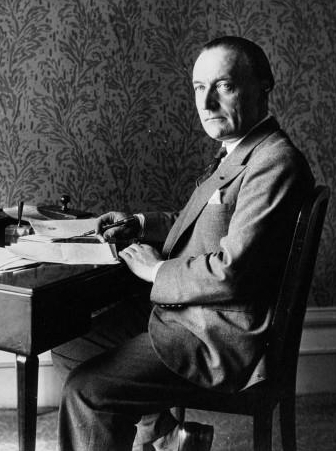 Jules Romains Another French refugee in New York was the novelist Jules Romains, whose decision to leave France was motivated in part by the desire to protect his wife, who was Jewish. Sailing from Lisbon, they arrived in New York in July 1940 and took a low-priced room at the Algonquin Hotel on West 44th Street, a famous gathering place for writers, journalists, and critics, where the management, knowing who their new guests were, upgraded them to a suite. Then they moved to the Hotel Mayflower on Central Park West at 61stStreet, where they ended up in a penthouse with a shared terrace: another example of the advantage of being preceded by one’s reputation and having the right connections. In New York the French exiles were not skimping along in a garret, picturesque as that might have been.
Jules Romains Another French refugee in New York was the novelist Jules Romains, whose decision to leave France was motivated in part by the desire to protect his wife, who was Jewish. Sailing from Lisbon, they arrived in New York in July 1940 and took a low-priced room at the Algonquin Hotel on West 44th Street, a famous gathering place for writers, journalists, and critics, where the management, knowing who their new guests were, upgraded them to a suite. Then they moved to the Hotel Mayflower on Central Park West at 61stStreet, where they ended up in a penthouse with a shared terrace: another example of the advantage of being preceded by one’s reputation and having the right connections. In New York the French exiles were not skimping along in a garret, picturesque as that might have been. Romains’s political views were not likely to please Bernstein, who was busy demolishing the image of Pétain that Maurois at first tried to preserve. A pacifist who had avoided military service in World War I, Romains had argued in the postwar years that only a reconciliation between France and Germany could bring lasting peace in Europe. This point of view, which might have been laudable in the years following World War II, was, to put it mildly, misguided and deplorable when he maintained it after Hitler’s rise to power. But Bernstein never attacked him with the vehemence he showed to Maurois. Romains participated in Voice of America radio broadcasts, then in 1941 went to Mexico, where he had many friends, to join with other French refugees in founding the Institut Français d’Amérique Latine. By now he was done with pacifism and gave lectures attacking Vichy. When peace came he returned to France, where he was elected to the Académie Française in 1946.
Bertolt Brecht
 Brecht, looking like a son of the people.
Brecht, looking like a son of the people.Bundesarchiv The fiercely anti-fascist German playwright Bertolt Brecht had collaborated with the composer Kurt Weill to create The Threepenny Opera (1928) and Rise and Fall of the City of Mahagonny (1930), both of which, savagely critical of capitalism, were great successes despite the vehement protests of Nazis in the audience. When Hitler came to power in 1933, Brecht left Germany, lived for a while in Denmark, and in July 1941, with his wife and harem (he always had a harem) came to the United States, where he wrote some of his most famous plays. An American who met him in New York in 1946 described him as a short, wiry man with close-cropped hair and a thin, bony face with a stubble of beard. Brecht, he reported, talked with a flow of nervous energy, his eyes sparkling with a wry sense of humor, as he radiated a great force of will that made him seem much younger than his age of 48. And he smoked cheap cigars.
Others were less generous, finding Brecht contentiously arrogant, manipulative, and even, since he disliked bathing, smelly. Thomas Mann called him a gifted monster, and W. H. Auden, with whom he collaborated, remarked that Brecht was one of the few people on whom a death sentence might be justifiably carried out. Though born into a comfortably middle-class German family, in photographs he always managed to look “proletarian” – close-cropped hair, plain clothes, grim-faced or with a faint, sly smile -- and in so doing repeated the gesture of Walt Whitman who, in the 1850s, presented himself to his readers as working-class and “one of the roughs,” a parallel that Brecht, had he been aware of it, would probably have rejected with disdain.
Though clearly an exile, Brecht was not really an exile in New York, which he visited occasionally, since he settled down in Hollywood -- the most curious of locales for an avowed Marxist in proletarian garb -- and then in Santa Monica. While still in Germany Brecht had known the U.S. chiefly through film and fantasy, and the names of its cities and states had had a certain exotic allure; now he could experience first-hand the glories and horrors of this bastion of capitalism. The U.S., for Brecht, was ignoble and loathsome, and Southern California a “Tahiti in metropolitan form” where the air was unbreathable and there was nothing to smell. Why was he there at all? Presumably because of the climate, the presence of a German-speaking community of fellow exiles (Brecht never learned English), and the possibility of making money in Hollywood (which he never did).
When the Cold War took hold, Brecht’s avowed Marxism got him into trouble. Summoned before the House Un-American Activities Committee in 1947, he testified that he had never been a member of the Communist Party, but smoked an acrid cigar that made some of the committee members slightly sick; the very next day he left the U.S. for Europe. In 1949 the offer of his own theater where he could fully realize his vision of epic theater induced him to return to Berlin, but to East Berlin in Communist-ruled East Germany, where his Berliner Ensemble became world-famous. A canny Marxist, he retained his Austrian passport while in East Germany and stashed the money from the Stalin Peace Prize, which he received in 1955, in a Swiss bank account. His detractors are quick to point out that he never denounced Stalin’s atrocities or the oppressiveness of the East German regime, but he influenced U.S. and European theater to a remarkable extent. He died of a heart attack in 1956 and is buried in Berlin.
Kurt Weill and Lotte Lenya
 Goggle glasses and a patterned bow tie
Goggle glasses and a patterned bow tieperched at his throat like a butterfly:
most definitely a bourgeois.
Bundesarchiv The German composer Kurt Weill was born into a middle-class Jewish family and was composing music by the age of thirteen. Photos show him, young or old, as a good bourgeois, serious, unsmiling, tightly buttoned and neat, with glasses – a far cry from Brecht’s proletarian (or pseudo-proletarian) image. In 1924 he met Lotte Lenya (an assumed stage name), an actress of Viennese working-class origins, whom he married in 1926. Though no classic beauty, as an actress and singer she had great stage presence, an untrained soprano voice that was unforgettable, and a raw, gutsy quality that suited perfectly the work of Weill and his collaborator Brecht, and that brought her instant fame in the role of Jenny in The Threepenny Opera (1928). Though hard to classify – opera, musical, or play with music? -- this work, an adaptation of John Gay’s Beggar’s Opera (1728), was an immediate success, treating audiences to a world of thieves, murderers, and prostitutes that shocked and fascinated them. By 1933 it had been translated into 18 languages and performed more than 10,000 times on European stages.
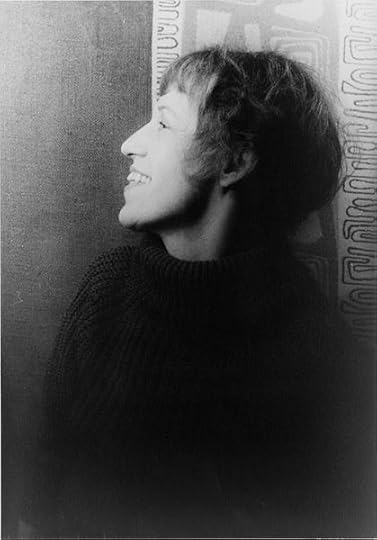 Not a great beauty, but incredibly
Not a great beauty, but incrediblydynamic on the stage, unforgettable. In spite of this success, Brecht and Weill soon distanced themselves from each other, primarily because, by 1929, Brecht’s ideas were tinged more and more with Marxism, and he was becoming increasingly opinionated and dictatorial. The rise of Hitler’s National Socialist Party put Brecht, Weill, and Lenya in danger, since they were known leftists and Weill was Jewish. Lenya was now living with the singer Otto Pasetti, and early in 1933 she initiated divorce proceedings against Weill, which may have been in part a tactical move, since it would let her reclaim some of his assets that might otherwise be seized by the Nazis. When Hitler came to power in March of that year, Weill and Lenya fled Germany separately. The pending divorce did not keep Lenya from performing in Brecht and Weill’s sung ballet (ballet chanté) The Seven Deadly Sins, which opened in Paris in June 1933 to mixed reviews and would be Brecht and Weill’s last collaboration. Three months later Lenya and Weill’s divorce became final. But by sometime in 1934 Lenya’s affair with Pasetti was over, and after a brief fling with the Surrealist artist Max Ernst, she became reconciled with Weill, who had been having an affair of his own with Erika Neher, the wife of the renowned set designer Caspar Neher, who worked closely with Brecht. In spite of their infidelities, Weill and Lenya always remained friends and collaborators and finally resumed their relationship. Even in free-living artistic circles old friends, it seems, are best.
In September 1935 the, dare we say, happy couple came to New York, residing first at the St. Moritz Hotel on Central Park South (not exactly a refuge for the impecunious) and later in an apartment at 231 East 62nd Street; they married again in January 1937. Convinced that his scores in Germany had been destroyed by the Nazis, Weill broke dramatically with his German past, speaking and writing German rarely, and studying American popular music so as to create works completely different from what he had done in Germany. Unlike Brecht, he and Lenya adapted to the capitalist American society and prospered. His American works never matched the earlier ones in bite, but some of his creations, notably “September Song,” had remarkable success. There are those who argue that his American career was not a sharp break with his past, but simply a new phase of it, but I’m not convinced. It’s quite a leap from “Mack the Knife” to “September Song,” and I can’t believe that any of the Broadway musicals he helped create had the keen edge of The Threepenny Opera, where Mack the Knife pronounces, “What is the robbing of a bank, compared to the founding of one?” (a statement that might well have resonance today).
Weill and Lenya moved into a house of their own in New City, Rockland County, in May 1941. He became a U.S. citizen in 1943 and died of a heart attack in a New York hospital soon after his fiftieth birthday on April 3, 1950; for weeks afterward, Lenya was so distraught that neighbors were afraid to let her stay alone at night. Despite the off-and-on infidelities, her life had been intimately linked to his ever since their first meeting in 1924.
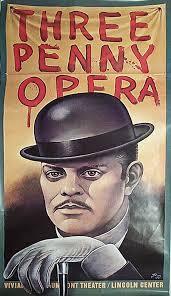 After Weill’s death Lenya, who in turn became a citizen in 1944, returned to the stage and performed memorably as Jenny in Marc Blitzstein’s brilliant 1955 Off Broadway revival of The Threepenny Opera at the Theatre de Lys in the West Village, a production that I was privileged to see twice. The first time, worn out from a long trip by car back from vacation on Cape Cod, I was swept along into the theater by some adventurous friends who followed some other people in, and so witnessed a dress rehearsal where I kept telling myself that this was a remarkable production, even as I caught myself nodding off and pinched myself awake.
After Weill’s death Lenya, who in turn became a citizen in 1944, returned to the stage and performed memorably as Jenny in Marc Blitzstein’s brilliant 1955 Off Broadway revival of The Threepenny Opera at the Theatre de Lys in the West Village, a production that I was privileged to see twice. The first time, worn out from a long trip by car back from vacation on Cape Cod, I was swept along into the theater by some adventurous friends who followed some other people in, and so witnessed a dress rehearsal where I kept telling myself that this was a remarkable production, even as I caught myself nodding off and pinched myself awake. The second time I saw Threepenny I was fully rested and alert, and confirmed my first impression that this was a remarkable event, and her now husky voice inimitable. From then on I was a devoted fan of anything that Brecht and Weill had worked on together, and anything that Lotte Lenya sang or performed in; she became a part of my New York experience. I will never forget her rendering of the song “Pirate Jenny” in The Threepenny Opera, where she plays a lowly and exploited hotel maid who imagines a pirate ship coming into the harbor to avenge her; when the pirates ask if she should kill some or all of the people, she answers tersely, in the German version, “Alle,” in that one short word conveying unforgettably the resentment and hatred toward their masters of the downcast and oppressed.
In the 1950s “Mack the Knife” became popular in the U.S.; you couldn’t avoid it. I loved the song but was troubled by its new status as a hit show tune that every pop singer wanted to have a crack at; divorced from its context in The Threepenny Opera, it was less sinister, less haunting.
Another New York triumph for Lotte Lenya was George Balanchine’s City Ballet production of The Seven Deadly Sins, newly translated by W. H. Auden and Chester Kallman, which opened in December 1958. The main character, Anna, is presented as a split personality. Lenya had the speaking and acting role, the rational Anna, her face framed by orange hair and bangs, with bold red lips and garish mascara, a grotesque appearance suggesting figures out of German Expressionism, the flagrant streetwalkers of Kirchner or the caricatures of Gross. The dancing role was performed by Allegra Kent, who would experience the seven sins in seven cities of a mythological America. By way of introduction Lenya informed the audience in her inimitable down-to-earth voice, with a glance at the lovely young dancer, “She’s the good-looking one; I’m practical.” In the original 1933 production by George Balanchine in Paris, Lenya had done the same role with Tilly Losch as the dancer, with the two of them about the same age and Losch bearing a remarkable resemblance to Lenya. In this New York production the fact that Lenya was 60 and Kent a mere 21 seemed irrelevant, given Lenya’s effectiveness in the role. As the two Annas seek their fortune and encounter the seven deadly sins in the cities of America, a male quartet (with the mother a bass in drag, another grotesque Expressionist touch) watch smugly and receive their earnings, which they use to gradually build a little house for themselves. Needless to say, the quartet represents the capitalist bourgeoisie exploiting the labor of workers. I’ll never forget the quartet’s insistent repetition:
Lazy bones are for the Devil’s stockpot. Lazy bones are for the Devil’s stockpot.
I saw the ballet twice and was overwhelmed by it. Amazingly, it was not revived by City Ballet until 2011.
From 1960 on Lenya lived in an apartment at 404 East 55th Street in New York. In 1961 she appeared in the movie version of Tennessee Williams’s The Roman Spring of Mrs. Stone as the enterprising Contessa who helps Vivian Leigh find a young Roman lover; for her performance Lenya was nominated for an Academy Award for Best Supporting Actress. She would marry again three times but, being determined to promote the works of her deceased husband, in 1962 she created the Kurt Weill Foundation for Music and oversaw vigilantly the revivals of his works, even to the point of attending rehearsals script in hand and following the performers line by line. More performances and recordings followed, and more honors. Keeper of the flame even when her own life was sputtering out, in her last days she embraced the acclaimed opera singer Teresa Stratas as her successor in keeping Weill’s music alive. Stratas moved in with her to see her through her last days as she succumbed to cancer. Lenya died on November 27, 1981, aged 83, and was buried beside Weill in Haverstraw, New York.
Source note: For information on Bernstein, Maurois, and Romains in New York, I am indebted to my longtime friend and comrade in the study and appreciation of French literature and culture, Jeanine Parisier-Plottel. Bernstein’s attack on Maurois is recounted in Maurois’s Mémoires; though Maurois doesn’t identify his attacker by name, it is obviously Bernstein.
This is New York
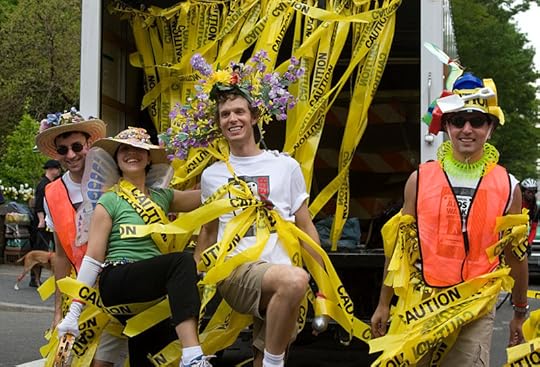 Jorge Royan
Jorge Royan Coming soon: A post on Remarkable Women: a prostitute’s daughter who slept in an empress’s bed, married and divorced an ex-vice president, and hobnobbed with ex-kings and a future emperor.
© 2014 Clifford Browder
Published on April 27, 2014 04:25
April 20, 2014
123. Wonder and Why We Need It
“The most beautiful thing we can experience is the mysteriousness. It is the source of all true art and science. He to whom the emotion is a stranger, who can no longer pause to wonder and stand wrapped in awe, is as good as dead – his eyes are closed.” So wrote Albert Einstein in his essay “The World as I See It.”
And Sergei Diaghilev, founder of the Ballets Russes, whose performances in Paris just before World War I electrified audiences and changed ballet forever, said to the young Jean Cocteau, who was beginning to make a name for himself in the theater, “Emerveille-moi!” (“Do me wonders”).
This post is about wonder, our sense of it, our need of it. In it longtime viewers of this blog will recognize themes of earlier posts, as for example trees (#71), insects (#34), silence (#55), and near-death experiences (#62). But what is wonder? A feeling of being surprised and overwhelmed by something, a revelation of something new and mysterious and meaningful, or the familiar transformed. It takes us out of ourselves, it puts us completely in the moment. As examples of experiences provoking wonder in my own life I would cite these examples:
· The rose windows of Chartres cathedral, incomparably beautiful, which, far from being embedded in a wall, seem suspended in space.
 Chartres, the rose window in the north transept. But no photograph can
Chartres, the rose window in the north transept. But no photograph can truly convey the beauty of a rose window.
Andreas F. Borchert· Dawn on Mount Canigou in the Pyrenees. Having climbed the mountain and spent the night in a chalet near the summit, on awaking early in the morning I looked out a window and saw the sky suffused with rose – the most beautiful sky I had ever seen; it cast a spell, it transformed me. Hurrying through breakfast, I rushed out to find the rose replaced by a milky white that was still magical, still enchanting. Fifteen minutes later I was at the very top of the mountain, but the milky white too had vanished, giving way to a bright, sunny day where every detail of the landscape stood out clean and clear. Impressive, but the awesome splendor, the mystery was gone.
· On Monhegan Island, off midcoast Maine, a turbulent ocean, roiled up by a storm the day before, breaking over Gull Rock, a ninety-foot-high slab of gray rock hunched up against the sea like a reclining giant, its rounded crest vanishing at intervals in a torrent of white spume: the most violent sight I have ever witnessed in nature, a display of raw, brute force compelling wonder and awe.
· Jacques Cousteau’s description of underwater reefs that he explored with the aid of the aqua-lung he had pioneered: corals like brain or staghorns or cactus or candelabras or skulls of dwarfs and giants; clams with shells ajar, displaying swollen mantles like the painted lips of harlots; sinister moray eels glowering from crevices with bared teeth; a crumpled feather bonnet that explodes into the bristles of a lion fish; and two hundred feet down, the boundary of reason and the beginning of rapture of the depths, as danger becomes voluptuous and enticing and the diver is lured ever downward toward steep walls of white walking canes, witches’ heads, and giant sponges festooned with spider webs: vistas he must renounce or risk his life.

That is all very fine, you may say, but Chartres and Mount Canigou and an island off midcoast Maine and underwater reefs in the tropics are not exactly urban phenomena, and this blog is supposed to be about New York. Where in this crowded, noisy city is one supposed to experience wonder?
Not easy. For what characterizes this city is precisely what inhibits a sense of wonder:
· Noise· Hurry· Busyness, exertion· Concern with the practical· Greed, the obsessive preoccupation with money · Ambition, the drive to get ahead· Skepticism, doubt, irreligion
Certainly, to experience a sense of wonder one wants quiet and calm, freedom from practical concerns, and an abatement of ego. Which for New Yorkers isn’t easy. And yet, there is wonder to be had, if we look for it.
 A sycamore bud opening.
A sycamore bud opening.Evelyn Simak This is April, the miracle month, when buds open and parks and gardens come alive. Look at an opening bud: a tiny clenched fist that gradually begins to loosen and expand into leaves and flowers – for me, an emblem of all beginnings of life, even the embryo in the womb. From nothing, or almost nothing, a clenched bud or the tiniest speck of a seed, comes the wonder of life, which we take so much for granted.
And trees, whose glories I have already sung (post #71). Both the majesty of their skeletal architecture in winter, and the vast expanse of their rustling leaves, pulsing and shimmering in the sun, when traversed by summer breezes.
And light on water, any water, whether a puddle or a river or the sea, if one looks toward the sun: depending on how much or how little wind there is, sheets or splotches of light, dancing tiny silver specks, a pulsing, glistening expanse that so fascinates me and sucks me into it, that I would almost call it the living face of God.
 Clinton and Charles Robertson And insects, which can be seen, with patience, in the city’s parks. Monarch butterflies (now, alas, endangered) migrating north from Mexico in spring to feed on milkweed here, and then returning there in autumn. In Maine in the fall I have caught the tail end of the migration, with their orange wings boldly lined with black fluttering over or perched and feeding upon the blue or purple asters. Their numbers wax or wane from season to season; some years I was told that at the peak of the migration they were so thick that you could almost walk through a field of them, brushing them gently aside as you went. But even here in the city you can see them in smaller numbers in the parks.
Clinton and Charles Robertson And insects, which can be seen, with patience, in the city’s parks. Monarch butterflies (now, alas, endangered) migrating north from Mexico in spring to feed on milkweed here, and then returning there in autumn. In Maine in the fall I have caught the tail end of the migration, with their orange wings boldly lined with black fluttering over or perched and feeding upon the blue or purple asters. Their numbers wax or wane from season to season; some years I was told that at the peak of the migration they were so thick that you could almost walk through a field of them, brushing them gently aside as you went. But even here in the city you can see them in smaller numbers in the parks.Or the sinister beauty of the praying mantis, its spiked forelegs waiting patiently for some unwary victim to venture into their lethal embrace and be trapped and eaten alive.

And the familiar honey bee, whose mating habits elicit wonder perhaps tinged with horror. The virgin queen bee in her one nuptial flight soars into the air and the drones, the males, follow; the queen then mates in midair with one after another – maybe a dozen or more – each of whom ejaculates with such force that his penis ruptures and is left inside the queen, following which, emasculated, he falls to the ground and dies. Leaving a trail of dead drones in her wake, the queen, with their sperm stored inside her, returns to the hive to begin her endless task of laying as many as 2,000 eggs a day, thus assuring the survival and continuance of the hive. For a sensitive and dramatic account of this and other aspects of the honey bee’s existence, poet and playwright Maurice Maeterlinck’s The Life of the Bee (1901) is essential, even if it needs to be supplemented today.
But mating is only one phase of the mysterious life cycle of the hive, the whole of which inspires even greater wonder and awe. And maybe a warning to the males of all species: once you have implanted your sperm, biologically you are no longer needed and can easily be dispensed with. And so, guys, if you want to stick around, make sure you make yourself needed in some other way.
And now, having glanced at these minuscule creatures, let’s engage with vastness: the night sky strewn with stars, albeit not easily seen in the city unless one goes to a rooftop, a pier, or a park (if one cares to venture at night into a park). But if we do and see the starlit heavens, we can be mesmerized, yanked out of our worries and concerns, and vaulted into some higher awareness. Having read The Universe Story by cosmologists Brian Swimme and Thomas Berry, I can envision the first flaring forth, the explosion of primordial energy, never to be equaled again, as frenzied particles cascade into existence, and gigantic galaxies pinwheel through the dark emptiness of space, creating clusters of systems, and clusters of clusters of systems, till the Milky Way begets ten thousand new stars, including our Sun, and the clouds of elements hovering about the Sun give birth to that tiny fragment of the cosmos that we presume to apprehend, the planets, including what Swimme and Berry call “the extravagant, magical, and living Earth.” The universe, they conclude, is a celebration of existence and life and consciousness, of color and sound and movement, of living and dying – a celebration in which we humans must participate. There is only one story, the story of the universe, and every form of being – ourselves included – is an integral part of it.
 ESO/A. Fitzsimmons
ESO/A. FitzsimmonsAll this, out of a glimpse of the sky at night? Yes, for that glimpse, or even the mere memory of it, points me to the cosmos, to vastness, to the mystery of origins. Just reading my scribbled notes on Swimme and Berry, I am swept away, humbled, overwhelmed. What they and other cosmologists give us is the modern Genesis, to which the only conceivable response is wonder.

Contemplating the cosmos, or some significant part of it, isn’t the only gateway to wonder. Certain lines of poetry, even when torn from their context, grab me in a more modest, but still inspiring, way:
· “The unplumbed, salt, estranging sea.” (The last line of Matthew Arnolds’s “Dover Beach,” and surely the best line he ever wrote.)
· “DETERMINED, DARED, and DONE.” (The triumphant last line of Christopher Smart’s “A Song to David.”)
· “plus vaste que nos lyres” (Yes, even a fragment of a line can reach me. From Rimbaud’s “Le Bateau ivre,” a magical poem that never fails to dazzle me.)
· “with the absolute heart of the poem of life butchered out of their own bodies good to eat a thousand years.”
(The last line of Alan Ginsberg’s “Howl,” another magical poem.)
Swimme and Berry’s cosmos overwhelms me; these lines simply hint at mystery, but mystery is the key to everything, and certainly to wonder and awe.
If literature can lead to wonder, then why not all the arts? Of course. For dance, the ending of Jerome Robbins’s Illuminations, inspired by Rimbaud’s poetry: the poet, his forearm bleeding with a wound inflicted by profane love, watches as in the distance sacred love, all in white, arabesques back and forth, back and forth, hypnotically. (In real life Rimbaud had indeed been shot by his angry lover, Verlaine – an instance of very profane love.)
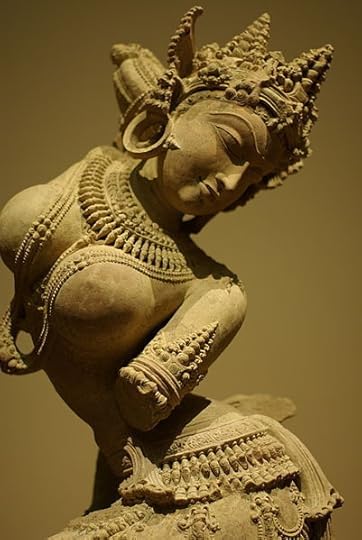 For sculpture, the dancing Hindu attendant to the gods at the Met, and Shiva’s cosmic dance, both in the marvelous South Asian hall, give me a feeling of mystery and wonder, though almost any Buddha could surely do the same.
For sculpture, the dancing Hindu attendant to the gods at the Met, and Shiva’s cosmic dance, both in the marvelous South Asian hall, give me a feeling of mystery and wonder, though almost any Buddha could surely do the same.For painting, Kandinsky’s four abstract compositions at the Museum of Modern Art, created in 1914 for the American collector Edwin R. Campbell. For me, their explosions of line and form and color express primordial energy akin to that evoked by Swimme and Berry.
As for the cosmic in music, one can’t do better than Bach.
Too artsy-fartsy? All right, how about higher math? In the New York Times Book Review section of December 5, 2013, I was amazed to read a review of Love and Math: The Heart of Hidden Reality, by the mathematician Edward Frenkel. Frenkel, a Russian immigrant who became a professor of math at Harvard at the tender age of twenty-one and now teaches at Berkeley, says that as a boy he was hit by the beauty of mathematics like a coup de foudre; in other words, he was suddenly, totally, and hopelessly smitten. And when, still in his teens, he made a new mathematical discovery, it was “like the first kiss.”
The beauty of math? Falling suddenly in love with it? For most of us, once mired in the intricacies of algebra, this at first seems close to inconceivable. My mother used to say that, with effort, she could figure out x, but she didn’t have a clue as to what to do with it. Like Mom, like son: I have to enlist myself in the same army of ignoramuses, even though in high school, idiotically, I pursued the affair into the abstruse realms of trigonometry, of which I remember not one jot or tittle.
But Professor Frenkel is of another tribe altogether. He insists that mathematics must be beautiful; there is no room in the world for ugly mathematics, and the fitting response to it is love. A photo shows him teaching at Berkeley in 2010 with dark, somewhat tousled hair, in a polo shirt and jeans, gesturing earnestly in front of a blackboard inscribed with mathematical formulae. His fervor is obvious. Yes, decidedly a lover.
 Edward Frenkel at Berkeley in 2010.
Edward Frenkel at Berkeley in 2010.Eget vaerk, Soren Fuglede Jorgensen
But Frenkel takes it further: mathematical structures, he insists, are every bit as real as anything in the physical or mental world. Nor are they human inventions. Like Plato’s ideas, they exist timelessly in a realm of their own, awaiting discovery by mathematicians. And these structures or patterns, emerging unexpectedly, hint at something hidden and mysterious. And if they are not of our making, who put them there? Frenkel doesn’t mention God, any more than Swimme and Berry (a Jesuit, by the way) posit a Divine Force initiating the first flaring forth. But Frenkel’s mathematical world is in the end one of awesome mystery, of wonder.
And if mathematics can lead us there, what cannot? Wonder, and all it implies, seems to be the ultimate goal, acknowledged or not, of the human race. To be without wonder is to be entombed in desolation. Whatever our woes (and they are real), we aren’t meant for desolation; we are meant for celebration and joy.
For believers, wonder leads us back to the Creator, whose ways are truly wondrous and mysterious. For nonbelievers it points to the mystery of origins and endings, and the final mystery that we must all one day confront. Having begun, like all organic life, in the sea, we will end where the cosmos began -- in light. Immeasurable, incomparable light.
Note on the callery pear: For years I wondered what those small to medium-size trees are that at this time of year, still leafless, explode into masses of small five-petaled white flowers all over New York City, but no one I asked could tell me. They are everywhere along the streets and in the parks, but for me they remained a mystery. I knew they belonged to the rose family, as do apple and cherry trees and most of the common native fruits, but that was all. Finally, a year ago, I consulted the city’s Parks and Recreation Department, and they gave me the answer: my mystery tree is the callery pear (Pyrus calleryana), a name I had never heard before. It is a planted tree, not a wild one, native to China and Vietnam, but the second commonest tree on the city’s streets. View it while it’s in riotous bloom, but don’t expect a luscious, soft, edible fruit; the reddish fruit is small, hard, and inedible for humans, though birds will feed on it once it has been softened by frost. But you probably won’t even notice it, or the tree itself, once the flowers are gone. This is its moment; enjoy it.

This is New York

Coming soon: Exiles in New York, part 4: strife among the Gauls; an exile who hated bathing, Southern California, and capitalism; and a keeper of the flame with orange bangs. And then some more famous deaths.
© 2014 Clifford Browder
Published on April 20, 2014 04:56
April 13, 2014
122. Exiles in New York, part 3
This is the third post on Exiles in New York. Originally I anticipated only one post, but I found such interesting characters that it soon become two posts, then three, and now four, but four, I insist, is the limit. New York has always been a refuge and new home for those fleeing oppression – or scandal or debt or irrelevance – in the Old World. It is the gateway to the New World, a land of opportunities where people can try out new lives, new identities, new ideas.
Marc Chagall
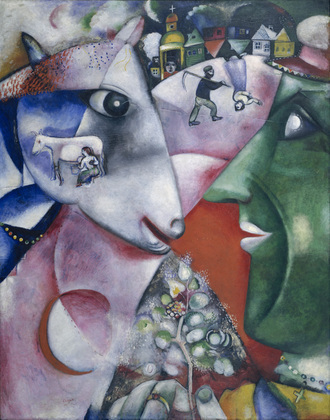 I and the Village, 1911. A giant cow’s head with a milkmaid inside it, a trudging peasant with a scythe, upside-down houses, a sprig of flowers, and a huge green human face. Or a floating couple above a bright red floor, the husband kissing his wife who holds a bouquet of flowers. Or a winged fish with a violin above a pendulum clock drifting in midair, against a blue riverscape and, on one bank, a pair of clasping lovers. These are some of the Chagall paintings that I have seen at the Museum of Modern Art, often labeled Surrealist, whimsical, primitive, dreamlike, or Expressionist, though none of these terms conveys fully and accurately the unique quality of his art.
I and the Village, 1911. A giant cow’s head with a milkmaid inside it, a trudging peasant with a scythe, upside-down houses, a sprig of flowers, and a huge green human face. Or a floating couple above a bright red floor, the husband kissing his wife who holds a bouquet of flowers. Or a winged fish with a violin above a pendulum clock drifting in midair, against a blue riverscape and, on one bank, a pair of clasping lovers. These are some of the Chagall paintings that I have seen at the Museum of Modern Art, often labeled Surrealist, whimsical, primitive, dreamlike, or Expressionist, though none of these terms conveys fully and accurately the unique quality of his art.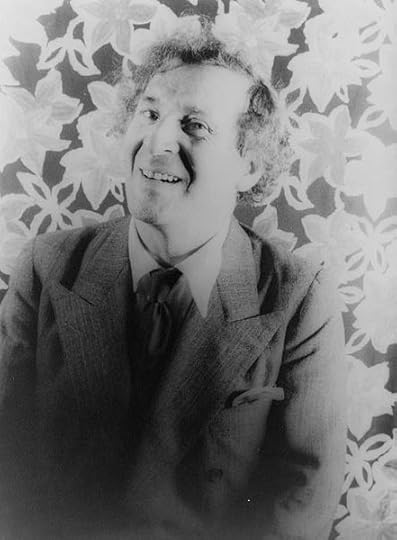 Born to a family of observant Hasidic Jews near the city of Vitebsk in imperial Russia, all his life Chagall would express in his art the memories and impressions of his childhood, the very images that I would see here in New York. The 1917 Revolution offered Chagall opportunities denied him as a Jew under the Czars, but in time he moved to France, where he was recognized as a major Modernist artist. Inevitably, his work was denounced as degenerate by the Nazi authorities in Germany, but after the Fall of France in 1940 he and his wife Bella remained in Vichy France, unaware at first of the threat there to Jews. With the help of a forged visa supplied by an American vice-consul in Marseilles, they finally left France in May 1941 and arrived in New York in June.
Born to a family of observant Hasidic Jews near the city of Vitebsk in imperial Russia, all his life Chagall would express in his art the memories and impressions of his childhood, the very images that I would see here in New York. The 1917 Revolution offered Chagall opportunities denied him as a Jew under the Czars, but in time he moved to France, where he was recognized as a major Modernist artist. Inevitably, his work was denounced as degenerate by the Nazi authorities in Germany, but after the Fall of France in 1940 he and his wife Bella remained in Vichy France, unaware at first of the threat there to Jews. With the help of a forged visa supplied by an American vice-consul in Marseilles, they finally left France in May 1941 and arrived in New York in June. A celebrity in a country whose language he could not speak, Chagall lived at 4 East 74th Street, visited galleries and museums, and became friends with other exiles like Piet Mondrian and André Breton. He especially relished visiting the Lower East Side, where he could have Jewish food and read the Yiddish press, his main source of news, since he hadn’t mastered English. Yet contemporary American artists had little appreciation of Chagall’s art until Pierre Matisse, the painter’s son, sponsored exhibitions of his work in New York and Chicago in 1941. Asked by the choreographer Leonid Massine to design the sets and costumes for his new ballet Aleko, he did so with such success that at the premiere in September 1942 he was included in the curtain calls, to tumultuous applause.
Chagall’s life in New York was not altogether happy, since he yearned for Paris and Vitebsk, and felt guilty for having abandoned his people in a time of persecution. To convey his anguish at the Nazi extermination of Jews, his art began to show Christ as a Jewish martyr next to a burning shtetl, a new phase of work contrasting sharply with the childlike and fanciful works preceding it. In 1944 he was stricken by the news that his beloved Vitebsk, long occupied by the Germans, had been destroyed in fighting between the Germans and Russians, and later that same year his wife Bella died suddenly from an infection, following which he couldn’t work for months.
Grateful to America for providing him with a wartime refuge, he returned to Paris in the fall of 1947. He is well remembered here, and two immense paintings of his adorn the front lobby of the Metropolitan Opera House at Lincoln Center.
Me and Chagall: When I first encountered Chagall’s works here in New York, I was charmed. Then, over the years, I decided that he was offering a bag of tricks – floating lovers, the fiddler uncle, upside-own houses, the Eiffel Tower, flying clocks – that were repeated far too often; I was tired of them. Too folksy, too childlike, too naïve or pseudo-naïve. It all seemed just a bit flimsy, an impression I never got from Picasso, Matisse, or the German Expressionists. A gifted illustrator and set designer, perhaps, but not a great artist. Now I find that many critics agree, though just how critical of him they are varies greatly. It seems a commonly accepted conclusion that early Chagall is good, and late Chagall bad. And when I see a reproduction of Praying Jew, a 1914 work in black and white showing its subject, bearded and hunched, in a prayer shawl, I am again impressed: no flying figures, no blasts of color, but instead a very solid figure devoid of fantasy and whimsy and engrossed in prayer. Yes, Chagall had his moments. I just wish there had been more of them.
Sergei Rachmaninoff
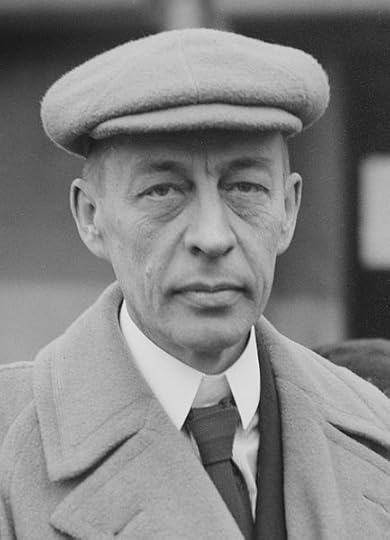 If the Russian Revolution created new opportunities for Chagall, it did just the opposite for Rachmaninoff, since his family were impoverished members of the old Russian aristocracy. His status as a world-famous composer, pianist, and conductor could not prevent the loss of his estate, his way of life, and his livelihood. At age 44, in December 1917 he left Petrograd (soon to become Leningrad) for Helsinki, Finland, with his wife and two daughters on an open sled, taking with him only a few notebooks with sketches of his own compositions and some other works. After giving concerts in Scandinavia for a year, he decided that the U.S. might offer the best financial opportunities and came to New York in November 1918. He was soon giving concerts and signing contracts, and in 1921 bought a five-story house at 33 Riverside Drive, near 72ndStreet, where he recreated the atmosphere of Ivanovka, his summer residence in Russia, hiring Russian servants, entertaining Russian guests, and observing old Russian customs. Homesick, he struck some of his friends as a melancholy aristocrat yearning for a past that could never be recovered. In 1925 he sold his house and moved into an apartment building at 505 West End Avenue, near 86thStreet, which remained his New York residence till the end of his life.
If the Russian Revolution created new opportunities for Chagall, it did just the opposite for Rachmaninoff, since his family were impoverished members of the old Russian aristocracy. His status as a world-famous composer, pianist, and conductor could not prevent the loss of his estate, his way of life, and his livelihood. At age 44, in December 1917 he left Petrograd (soon to become Leningrad) for Helsinki, Finland, with his wife and two daughters on an open sled, taking with him only a few notebooks with sketches of his own compositions and some other works. After giving concerts in Scandinavia for a year, he decided that the U.S. might offer the best financial opportunities and came to New York in November 1918. He was soon giving concerts and signing contracts, and in 1921 bought a five-story house at 33 Riverside Drive, near 72ndStreet, where he recreated the atmosphere of Ivanovka, his summer residence in Russia, hiring Russian servants, entertaining Russian guests, and observing old Russian customs. Homesick, he struck some of his friends as a melancholy aristocrat yearning for a past that could never be recovered. In 1925 he sold his house and moved into an apartment building at 505 West End Avenue, near 86thStreet, which remained his New York residence till the end of his life. Capitalist America was good to the exiled pianist. In the years that followed, his towering presence (he was 6 foot 6) was seen often in the concert halls of the U.S. and Europe giving concerts of dazzling virtuosity, and he prospered to the point that he acquired a home in Beverly Hills also, and a villa in Switzerland where he spent his summers from 1933 to 1939. His favorite piano was a Hamburg Steinway, of which he had two for his New York residence, two for his home in Beverly Hills, and one for his Swiss villa. When he published a letter in the New York Times in 1931 condemning the Soviet regime, that regime banned his works as “decadent.” He and his wife became U.S. citizens in 1943, and soon afterward he died of melanoma in Beverly Hills, just four days before his seventieth birthday. He wanted to be buried at his villa in Switzerland, but wartime conditions made this impossible, so he was interred in Kensico Cemetery in Valhalla, New York.
Quentin Crisp
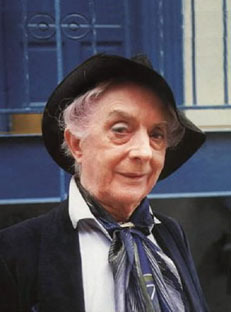 Admittedly effeminate from an early age, Quentin Crisp (an assumed name) survived schoolyard bullying to work briefly as a male prostitute in London (looking for love, he found only degradation), and attracted both admiration and hostility because of his bright make-up, dyed hair, and painted fingernails and toenails. During World War II he cruised about the streets in the blackout picking up G.I.s, whose kindness and tolerance inspired his love of all things American. His autobiography The Naked Civil Servant was published in 1968, but it was the 1975 TV version, broadcast by both British and U.S. television, that made him famous. After that he toured Britain with a one-man show comprising an entertaining monologue and a question-and-answer session with the audience.
Admittedly effeminate from an early age, Quentin Crisp (an assumed name) survived schoolyard bullying to work briefly as a male prostitute in London (looking for love, he found only degradation), and attracted both admiration and hostility because of his bright make-up, dyed hair, and painted fingernails and toenails. During World War II he cruised about the streets in the blackout picking up G.I.s, whose kindness and tolerance inspired his love of all things American. His autobiography The Naked Civil Servant was published in 1968, but it was the 1975 TV version, broadcast by both British and U.S. television, that made him famous. After that he toured Britain with a one-man show comprising an entertaining monologue and a question-and-answer session with the audience.For Quentin Crisp, New York City was love at first sight: “When I saw Manhattan, I wanted it.” He brought his show here in 1978, his stay at the legendary Chelsea Hotel coinciding with a fire, a robbery, and the death of Nancy Spungen (see post #121). Finding Britain homophobic and parochial, and New York more open, friendly, and welcoming, in 1981 he moved here permanently at age 72, arriving with few possessions and finding a tiny one-room apartment on East 3rd Street in the East Village, where he lived contentedly in squalor. (“There is no need to do any housework at all. After the first four years the dirt doesn’t get any worse.”) Listing his phone number in the telephone directory, he talked with anyone who called him. Dinner invitations poured in, and he accepted them all on condition that his dinner be paid for. In recompense, he entertained his hosts with colorful stories about his life, so that dining with him was soon said to be one of the best shows in New York. To support himself, he performed his one-man show, wrote movie reviews and columns for U.S. and British newspapers and magazines, acted on the stage and on TV, and of course dined out. By accepting every invitation to a cocktail party or premiere, he insisted, one could exist on peanuts and champagne. Easily recognized by his tilted hat and painted face, he was soon a venerated celebrity on the Lower East Side, where people waved at him on the street, bums greeted him, and deferential young men asked for his autograph.
Unpredictable and provocative, he outraged the gay community by calling AIDS a “fad,” and homosexuality “a terrible disease,” remarks that could be seen as self-hating and arrogant, or as a tongue-in-cheek bid for attention. Even as the gay lib movement swept America, he never spoke out for gay rights or endorsed campaigns against homophobia; his role, he felt, was simply to be himself. By now, for him sexual adventures were irrelevant. For many in gay life, he was too old-style camp, too flamboyant, not “cool.” Some critics saw him as jealous: gay liberation meant that he was no longer unique, the most visible queer in town, and he resented it. Be that as it may, he was certainly a loner, not a joiner.
Returning to England in poor health to tour with a revival of his one-man show, he died of a heart attack in a Manchester boarding house on November 21, 1999, one month before his 91stbirthday; he was cremated there and his ashes were flown back to New York to be scattered over Manhattan. Some thought his return to “merciless” England (his phrase), a trip obviously beyond his strength, was deliberately suicidal, based on the calculation that if he died in the U.S. he would get an obit on page 10, whereas if he died in England on the eve of a farewell tour, and with a play about him running in London, his death would be front-page news. To the surprise of many, his estate was valued at over $600,000.
His wit was proverbial. Planning to move to the U.S., he was interviewed at the U.S. Embassy in London and asked if he was a practicing homosexual. “I didn’t practice,” he replied. “I was already perfect.”
Other instances:· Never keep up with the Joneses. Drag them down to your level.· Life was a funny thing that happened to me on the way to the grave.· An autobiography is obituary in serial form with the last installment missing.· To know all is not to forgive all. It is to despise everybody.
He is now revered for simply being himself, for not hiding his homosexuality but flaunting it, for making the outrageous acceptable. Kathleen Egan in the New York Times called him “an anarchist armed with a compact.” His credo: Be yourself, whatever the cost. To which one might add: Above all, do it with flair.
Louis Napoleon
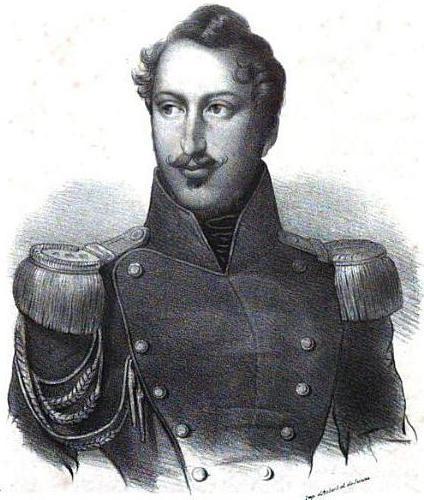 After a failed coup d’état in Strasbourg in October 1836 and a resulting short stay in prison, Louis Napoleon, the nephew of the great Napoleon and future Emperor Napoleon III of France, at age 29 felt a sudden urge to visit the New World and, disembarking in Norfolk on March 30, 1837, proceeded to New York. Installed in a hotel here, he is said to have met some of the best French and American society in the city, as well as Washington Irving, who invited him to his country estate. Already he was sporting the deliciously waxed mustache with its tips curled upward, and the tuft of beard below it, that would characterize his later glory days and become known as an impériale. His favorite topics of conversation were his uncle the Emperor, the reasons for the coup at Strasbourg, and his conviction that he was destined to rule France. Perhaps in imitation of Alexis de Tocqueville, whose influential work Democracy in America first appeared in 1835, he planned to tour the country so as to know American institutions better, but when informed that his mother was dying in Switzerland, he left the U.S. in haste so as to be with her until the end, which, after some delays en route, he managed to do.
After a failed coup d’état in Strasbourg in October 1836 and a resulting short stay in prison, Louis Napoleon, the nephew of the great Napoleon and future Emperor Napoleon III of France, at age 29 felt a sudden urge to visit the New World and, disembarking in Norfolk on March 30, 1837, proceeded to New York. Installed in a hotel here, he is said to have met some of the best French and American society in the city, as well as Washington Irving, who invited him to his country estate. Already he was sporting the deliciously waxed mustache with its tips curled upward, and the tuft of beard below it, that would characterize his later glory days and become known as an impériale. His favorite topics of conversation were his uncle the Emperor, the reasons for the coup at Strasbourg, and his conviction that he was destined to rule France. Perhaps in imitation of Alexis de Tocqueville, whose influential work Democracy in America first appeared in 1835, he planned to tour the country so as to know American institutions better, but when informed that his mother was dying in Switzerland, he left the U.S. in haste so as to be with her until the end, which, after some delays en route, he managed to do. As for his reception here by the French community, I suspect that he was welcomed warmly by the Bonaparte faction and greeted less warmly by the legitimists who wanted a Bourbon restoration, and the supporters of the then current regime of Louis Philippe, the “roi bourgeois.” Not to mention those who yearned for a republic. In those days the French, being politically versatile, had many options.
Be that as it may, Louis Napoleon was destined to influence fashion in this city and nation. Once he finagled his way into becoming, like his uncle, the Emperor of the French, his impériale was much imitated by the hirsute faction on these shores. And his consort, the Empress Eugénie, is said to have launched the vogue of the hoopskirt – a dubious claim to fame, given the difficulty stylish women had in maneuvering its ample proportions. There are at least three theories as to why she favored this outlandish innovation: (1) she wanted to hide her pregnancy (she would give birth to the prince impériale); (2) her couturier wanted to promote the French fabric and trim industry; (3) though acclaimed as a beauty, she had bad legs and wanted to hide them.
Lorenzo Da Ponte
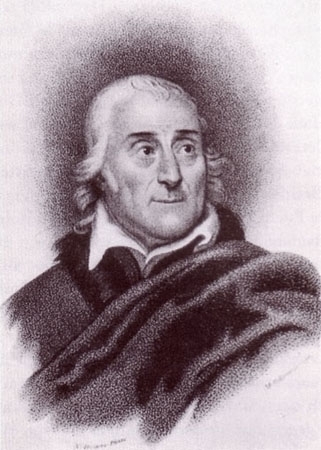 Jewish by birth, and a Catholic convert who became a priest unburdened by his vow of chastity (he hung out with Casanova), Lorenzo Da Ponte, known today as Mozart’s librettist, achieved a rare distinction by getting himself banished from sensual, easy-going Venice, his native city, for immoral conduct -- specifically for “public concubinage” and “abduction of a respectable woman.” Among his misdeeds were a mistress who bore him two children, and, so the story goes, his living in a brothel and organizing the entertainments there. His priestly duties, it seems, were a sideline, or maybe nonexistent.
Jewish by birth, and a Catholic convert who became a priest unburdened by his vow of chastity (he hung out with Casanova), Lorenzo Da Ponte, known today as Mozart’s librettist, achieved a rare distinction by getting himself banished from sensual, easy-going Venice, his native city, for immoral conduct -- specifically for “public concubinage” and “abduction of a respectable woman.” Among his misdeeds were a mistress who bore him two children, and, so the story goes, his living in a brothel and organizing the entertainments there. His priestly duties, it seems, were a sideline, or maybe nonexistent.Forced to leave Venice in 1779, he moved to Austria and finally turned up in Vienna, where he made the right connections and became the court librettist, working above all with Mozart on his best-known Italian operas. These, his glory days, ended when his patron, the emperor Joseph II, died in 1790 and was succeeded by a monarch who was quickly prejudiced against Da Ponte by his enemies at court. Da Ponte then transferred his talents to London, where he engaged in various theatrical and publishing activities, until debt and bankruptcy forced him to flee to the U.S., where he had already dispatched his wife and children (yes, he seems to have actually married this one), since she had relatives there. When, at age 56, he disembarked in Philadelphia in 1805, he possessed a violin and little else, having gambled his scant funds away on the voyage.
In America he settled first in New York, where he briefly ran a grocery store, then decamped for Pennsylvania, where he may have run a millinery and a distillery (accounts differ). Returning to New York, he opened a bookstore and a rooming house where the roomers, many of them students at Columbia College, savored his sophisticated talk about the arts, Mozart, and Italian cooking. He also taught Italian, primarily to young women, which, given his past, might make one fear for their chastity, though by now his sexual misadventures had probably come to an end. White-haired and toothless, he still managed to ooze an Old World charm that won him many friends, though his tales about himself and his accomplishments were such as to inspire mistrust. In time he taught Italian literature at Columbia College, where he had no fixed salary but was paid for each student enrolled. Alas, after the first year he had zero students and therefore zero pay. But he remained on the college faculty for thirteen years, and so became the first Jewish-born professor and the first Catholic priest to teach there, though by now he passed for an Anglican.
His two great passions were opera and Italian literature, and he was determined to make them both better known in this raw, vital city in this raw, vital land. In 1825 he mounted a performance of Don Giovanni in New York, then introduced Rossini’s music to the U.S. through a concert tour with his niece. In 1833, at age 84, he founded the New York Opera Company, the first opera house in the country, but his financial acumen had not improved, and after two seasons the company was disbanded and the theater sold to pay its debts. A U.S. citizen since 1828, he died here in 1838 and was honored with an enormous funeral ceremony in the Catholic cathedral on Mulberry Street. What became of his remains is unknown, since the cemetery where he was buried was closed soon afterward and the graves relocated elsewhere.
An astonishing life, or maybe one should say lives, since he kept reinventing himself and tried his hand at everything, a Venetian Jew turned Catholic priest turned Anglican with a talent for seduction and debt. Still, he initiated the teaching of Italian literature and induced an interest in opera in a city and nation that up till then were blissfully ignorant of both. Though the location of his remains is uncertain, a tombstone was belatedly put up in 1985 in the Calvary Cemetery in Queens.
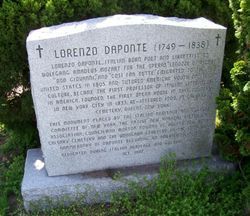 One tombstone could hardly hold all the man's accomplishments.
One tombstone could hardly hold all the man's accomplishments.R.E.H.
AMERICANS ARE PIGS
So spoke Harold Clurman, when commenting long ago on the characters in a scene presented in the Playwrights Unit of the Actors Studio. (A very good scene, incidentally, and well acted.) His words often come to mind when, returning from errands, I notice the cigarette butts and stray bits of paper tossed in the small front area of the building next door. That area is well kept by my neighbor, who plants things there. But Americans, alas, think that every garden is an ashtray, and every park a trash dump. At times, in the course of my hikes, I have walked for a short distance beside a highway and noticed the litter there: plastic cups and utensils, brown paper bags, cigarette butts, bits of paper, even whole newspapers. People seem to think that, if they toss trash out a car window, it will somehow disappear. But it doesn't. Yes, Americans are pigs. One welcome exception is the state of Maine, which really strives to keep its highways clean. Billboards are limited, and there is almost no litter at the sides of roads; you can actually enjoy the landscape, and the landscape there is well worth looking at. But New York State, like most states I have visited, is strewn with trash. Yes, alas, Americans are pigs.
This is New York
 Stuart Sevastos
Stuart SevastosComing soon: To celebrate Easter and the miracle of the Resurrection, next Sunday’s post will be Wonder: Our Need of It, with comments on Mount Canigou at dawn, Chartres, opening buds, brain coral, the first flaring forth, the beauty of mathematics, the wisdom of the body, and related matters. After that, one more glance at exiles, another at famous deaths in New York, and probably a post on Remarkable Women (I have a juicy trio in mind).
© 2014 Clifford Browder
Published on April 13, 2014 04:41



